If 2025 had a theme, it would be growth. Every second, more than one new developer on average joined GitHub—over 36 million in the past year. It’s our fastest absolute growth rate yet and 180 million-plus developers now work and build on GitHub.
The release of GitHub Copilot Free in late 2024 coincided with a step-change in developer sign-ups, exceeding prior projections. Beyond bringing millions of new developers into the ecosystem, we saw record-level activity across repositories, pull requests, and code pushes. Developers created more than 230 new repositories every minute, merged 43.2 million pull requests on average each month (+23% YoY), and pushed nearly 1 billion commits in 2025 (+25.1% YoY)—including a record of nearly 100 million in August alone.
This surge in activity coincides with a structural milestone: for the first time, TypeScript overtook both Python and JavaScript in August 2025 to become the most used language on GitHub, reflecting how developers are reshaping their toolkits. This marks the most significant language shift in more than a decade.
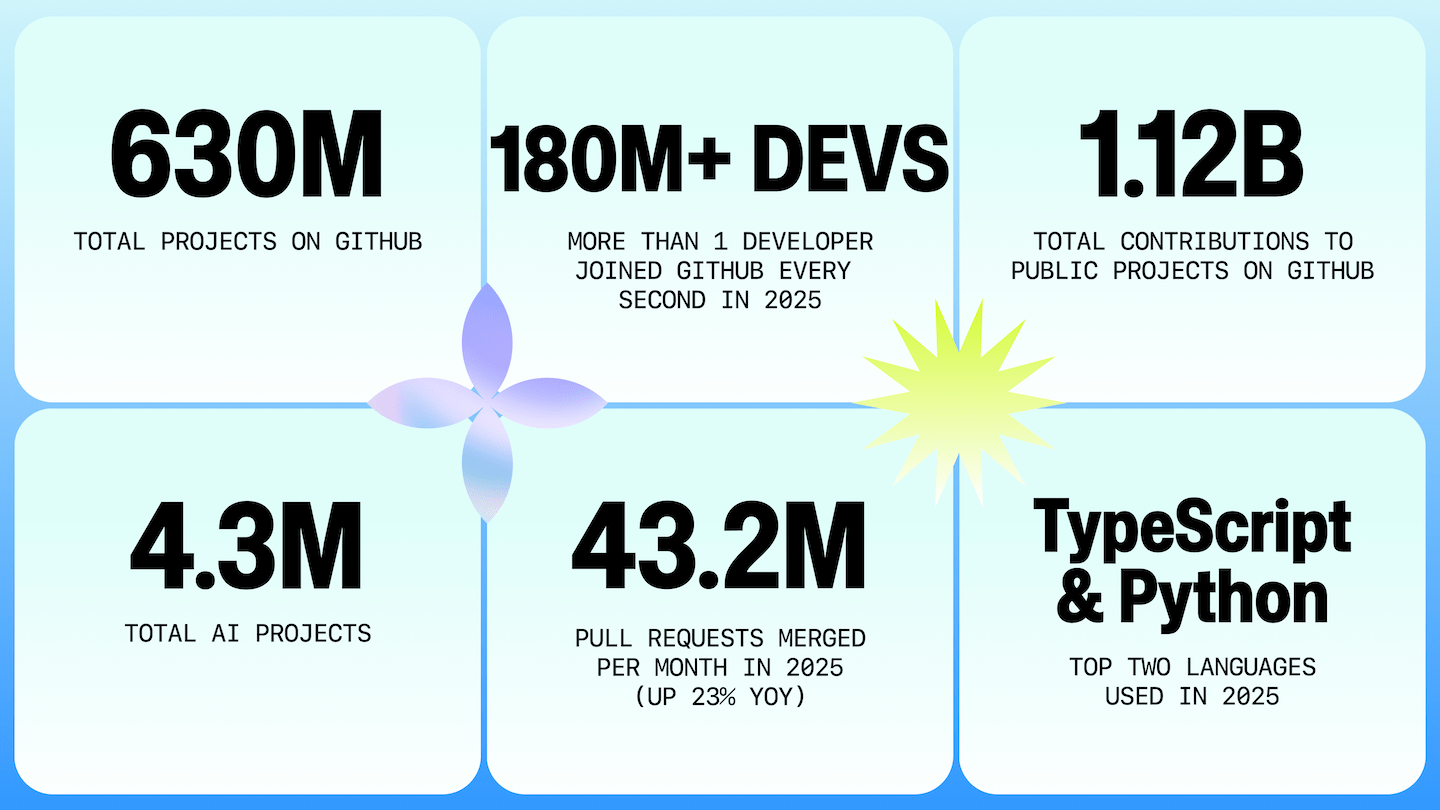
And the growth we see is global: India alone added more than 5 million developers this year (over 14% of all new accounts) and is on track to account for one in every three new developers on GitHub by 2030.
This year’s data highlights three key shifts:
- Generative AI is now standard in development. More than 1.1 million public repositories now use an LLM SDK with 693,867 of these projects created in just the past 12 months alone (+178% YoY, Aug ‘25 vs. Aug ‘24). Developers also merged a record 518.7M pull requests (+29% YoY). Moreover, AI adoption starts quickly: 80% of new developers on GitHub use Copilot in their first week.
- TypeScript is now the most used language on GitHub. In August 2025, TypeScript overtook both Python and JavaScript. Its rise illustrates how developers are shifting toward typed languages that make agent-assisted coding more reliable in production. It doesn’t hurt that nearly every major frontend framework now scaffolds with TypeScript by default. Even still, Python remains dominant for AI and data science workloads, while the JavaScript/TypeScript ecosystem still accounts for more overall activity than Python alone.
- AI is reshaping choices, not just code. In the past, developer choice meant picking an IDE, language, or framework. In 2025, that’s changing. We see correlations between the rapid adoption of AI tools and evolving language preferences. This and other shifts suggest AI is influencing not only how fast code is written, but which languages and tools developers use.
And one of the biggest things in 2025? Agents are here. Early signals in our data are starting to show their impact, but ultimately point to one key thing: we’re just getting started and we expect far greater activity in the months and years ahead.
Let’s jump in.
💡 Oh, and if you’re a visual learner, we have you covered.👇
The state of GitHub in 2025: A year of record growth

In 2023, GitHub crossed 100 million developers after nearly three years of growth from 50 million to 100 million. But the past year alone has rewritten that curve with our fastest absolute growth yet. Today, more than 180 million developers build on GitHub.
So, what does “more than one new developer joining GitHub every second on average” actually mean?
- Developers are converging on GitHub. More than 36 million developers joined GitHub in a single year (23% YoY), confirming GitHub as the primary hub for collaboration.
- AI adoption starts immediately. We see nearly 80% of new developers on GitHub use GitHub Copilot within their first week, offering evidence that AI is now an expectation among new coders.
- The talent boom is geographically diverse. Every minute, ~25 developers joined from APAC, ~12 from Europe, ~6.5 from Africa and the Middle East, and ~6 from LATAM. India alone added over 5 million developers this year.
GitHub Copilot steepened growth curves
Historically, developer sign ups and repository creation followed predictable year-over-year patterns. The launch of Copilot Free in December 2024 accelerated those curves globally, giving millions access to AI-powered workflows for the first time. The end result? Our typical models for growth overturned dramatically.
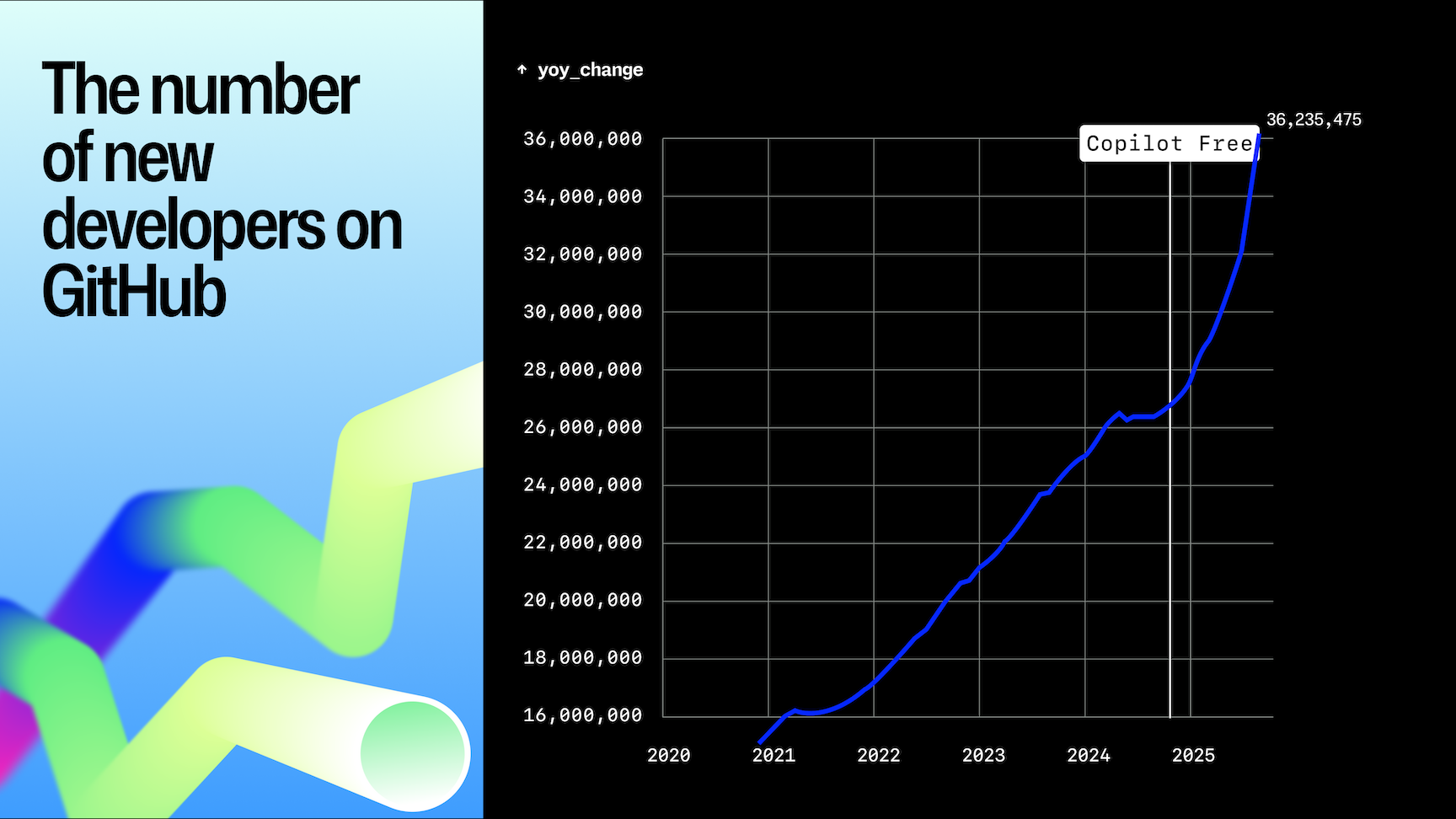
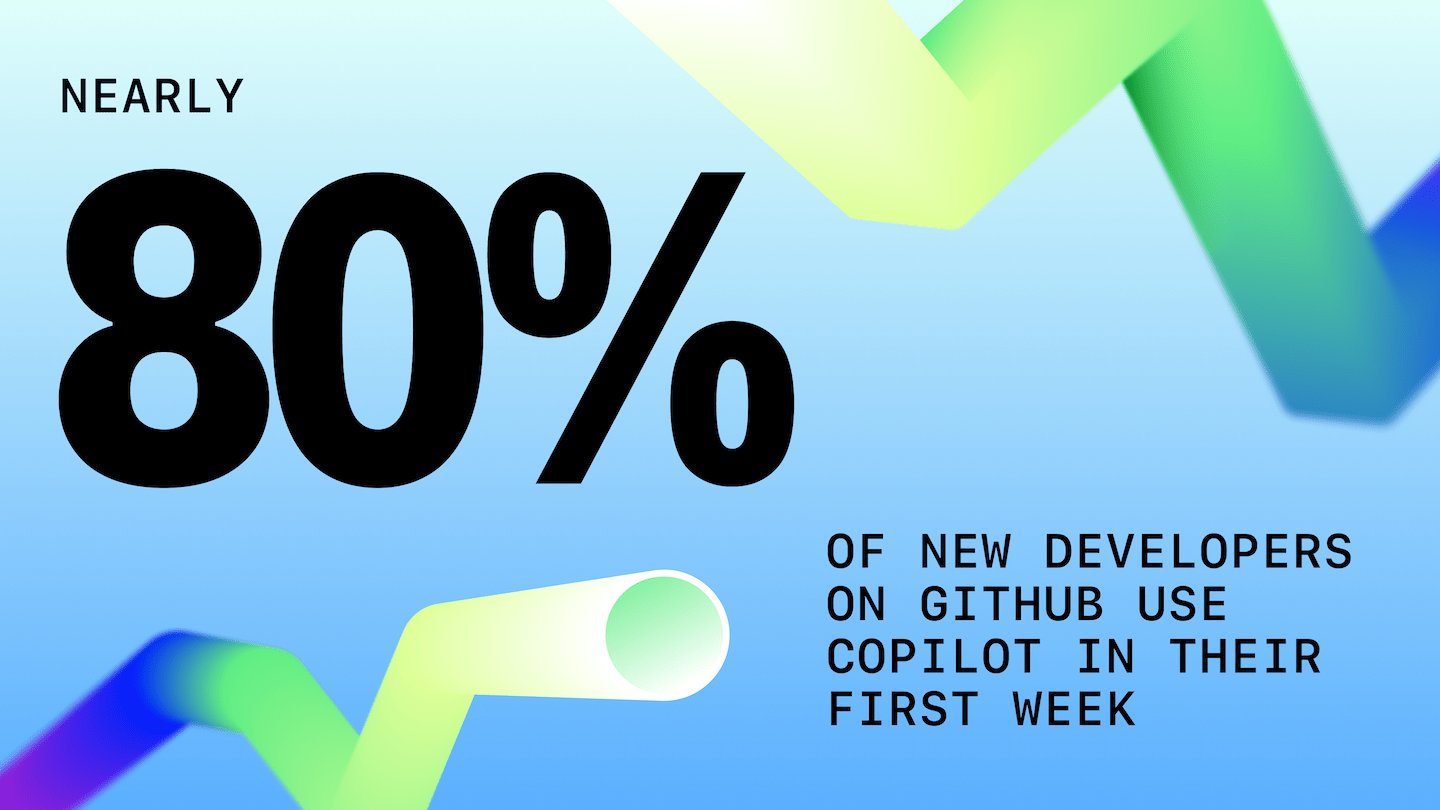
Private and public repositories play different but interdependent roles
In 2025, 81.5% of contributions happened in private repositories, while 63% of all repositories were public. The split highlights GitHub’s dual role: most day-to-day work takes place in private projects, but depends on libraries, models, and frameworks in public open source.
Private repositories also grew faster (+33% YoY) than public repositories (+19% YoY), reflecting the growth in organizational development happening on GitHub. We also sometimes see open source software (OSS) work start in private projects.
| 2025‑YTD lens | Contributions | Share of total | What it signals |
|---|---|---|---|
| Private repositories | 4.97B | ≈ 81.5% | Enterprise and team‑level collaboration is happening on GitHub. |
| Public repositories | 1.12B | ≈ 18.5% | The volume of work is smaller, yet these projects supply the libraries, models, and workflows that power the broader ecosystem. |
Key numbers
- 180M+ developers are now on GitHub
- 630M total repositories with +121M new repositories in 2025 marking our biggest year yet
- +58M private repositories (up 33%) underscore the activity happening outside of the public eye.
- Open source and public projects represent the majority of repositories on GitHub. 63% of all repositories are open source or public.
Developer productivity: shipping more, waiting less

2025 marked the most active 12-month period in GitHub history with more than 1.12B contributions to public and open source projects. Following the SPACE framework (a model that looks at developer Satisfaction, Performance, Activity, Communication, and Efficiency), this increase reflects record levels of developer activity. As developers are increasingly working with LLMs and agents, there are some new, notable correlations in this year’s data.
Developer activity reached record levels in 2025
Across every productivity signal on GitHub, developers set new records in 2025.
| Activity | 2024 monthly average | 2025 monthly average |
|---|---|---|
| Issues closed | ≈ 3.4M | 4.25M |
| Pull requests merged | 35M | 43.2M |
| Code pushes | 65M | 82.19M |
Momentum accelerated in early 2025 and coincided with the preview of Copilot coding agent in March and the introduction of Copilot code review in April. In March, developers closed 1.4 million more issues than the prior month, then continued breaking records, culminating in 5.5 million issues closed in July.
Code pushes are driving the surge with more than 986M commits in 2025 (+25% YoY) and monthly pushes topping 90M by May. Other activity followed:
- Pull requests created: +20.4% (47.5M vs 39.5M)
- Issues created: +11.3% (17.5M vs 15.7M)
- Comments on issues/PRs: essentially flat (+0.35%)
- Comments on commits: down -27% (sharp decline)
These are observational signals rather than causal claims and more work is needed to understand the full impact AI is having in software development.
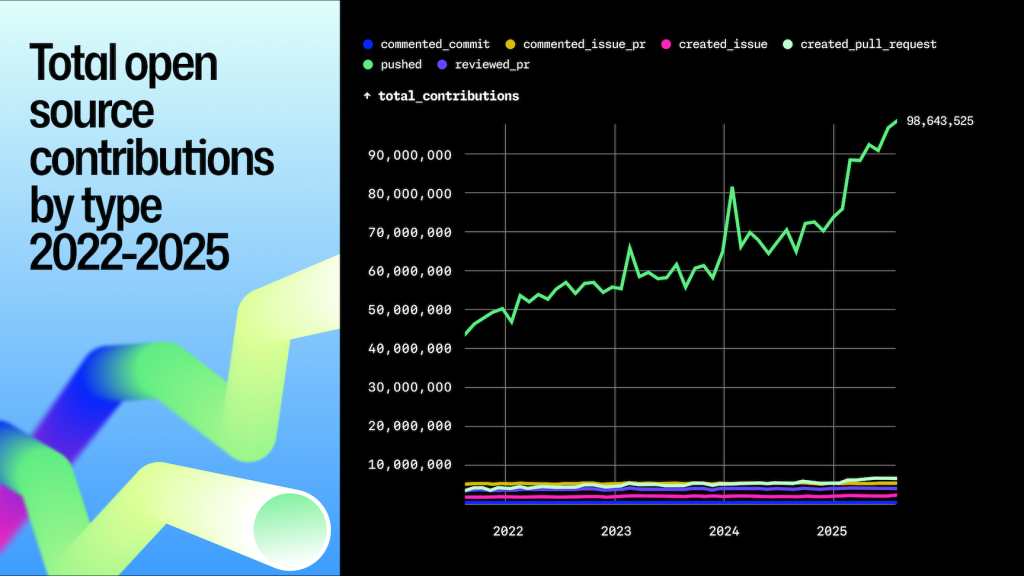
Jupyter Notebooks and Dockerfiles highlight two stages of modern development
Notebooks are now a mature tool for experimentation, while Dockerfiles are considered the bridge to reproducibility and production. In 2025, 2.4 million repositories used Notebooks (+75% YoY) and 1.9 million used Dockerfiles (+120% YoY). This growth is likely fueled by the need to sandbox agents and LLMs, and containerization is a practical method to run and scale them securely.
| Repositories in 2024 | Repositories in 2025 | Delta | |
|---|---|---|---|
| Jupyter Notebook present | 1.4M | 2.42M | +75% |
| Dockerfile present | 875k | 1.9M | +120% |
AI agents enter the mainstream
- AI code review helps developers. We conducted in-depth interviews with developers about their code review process and found that 72.6% of developers who use Copilot code review said it improved their effectiveness.
- Developers are using AI and agentic tools to build and share their work faster. Between the total number of developers on GitHub growing in tandem with the release of popular agentic tools and the overall activity increases in languages such as TypeScript and Python, 2025 data shows an increase in rapid prototyping and experimentation.
Where the world codes in 2025

The last five years have redrawn not just GitHub’s developer map, but also the distribution of global activity, faster than any period on record.
A new global top 10
India added more than 5.2 million developers in 2025, which accounts for a little over 14% of GitHub’s total +36 million new developers in 2025. That makes India the single largest source of new developers on GitHub this year, continuing its rapid rise since 2020.
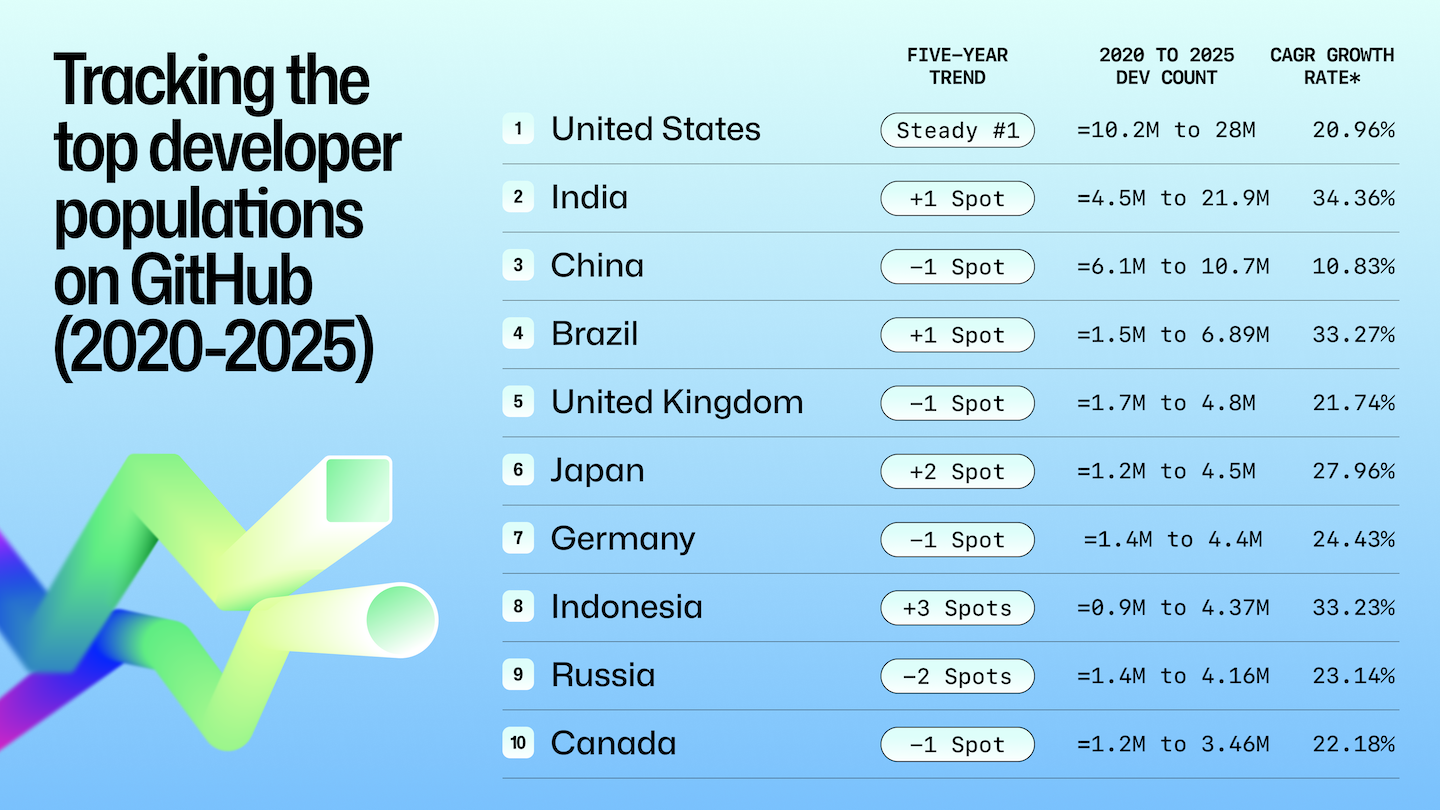
What changed?
- Significant growth came from India, Brazil, and Indonesia. These regions combine large, young developer populations with expanding internet access and booming startup ecosystems. Many are also seeing some of the fastest growth in AI-related projects, as local companies adopt new tools to compete globally.
- Over the past five years (from 2020 to 2025), India, Brazil, and Indonesia have more than quadrupled the number of developers on the platform; Japan and Germany have more than tripled their developer numbers; and the USA, UK, and Canada have more than doubled the number of developers on the platform.
- Brazil, in particular, is benefiting from activity investment in fintech and open banking.
- Indonesia continues to grow with its rise as Southeast Asia’s digital powerhouse (it accounts for nearly half the region’s online economy!).
Regional growth snapshots
| Region | Stand‑out markets | 2024 to 2025 net new devs | What’s fueling the boom |
|---|---|---|---|
| APAC | India, Japan, Indonesia, | +13M | Government skilling, AI‑assisted local‑language tooling. Japan, in particular, has embraced digital transformation in recent years, leading to a boom in developers. |
| LATAM | Brazil, Mexico, Colombia | +3.2M | Remote hiring by US/EU firms, fintech startup density |
| Europe | Germany, United Kingdom, France | +6.3M | Cloud infrastructure spend, AI investment, startup‑visa pipelines |
| Africa & the Middle East | Nigeria, Turkey, Egypt | +3.4M | Increased mobile adoption, community bootcamps, LLMs that work locally |
Modeling the global developer landscape through 2030
Looking ahead, our data team modeled the next five years of developer growth using regression analysis, which can help to capture more of the real-world dynamics impacting the data. (You can get more information about this in our methodology section.)
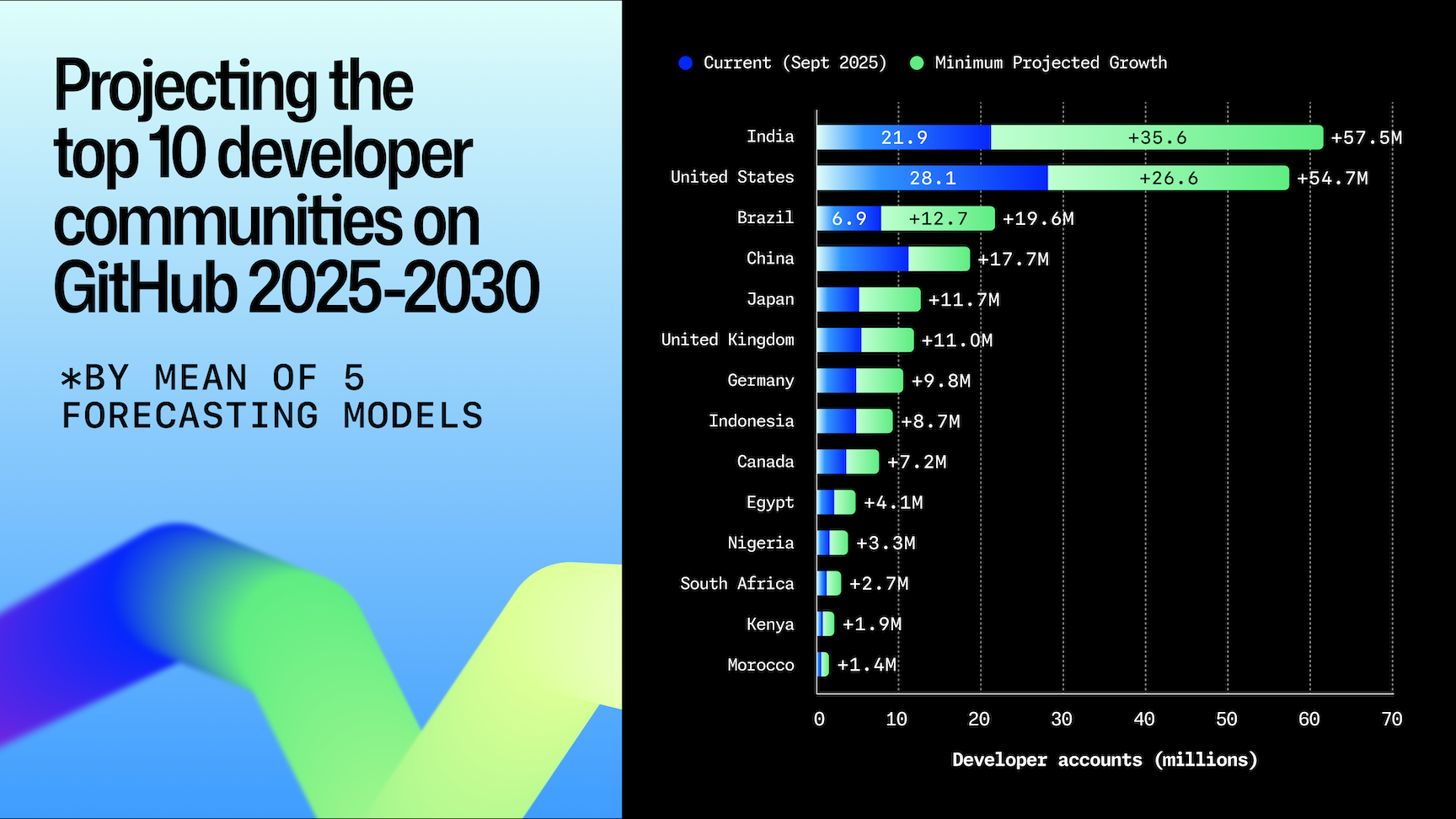
The results of our analysis suggest India will continue to expand its lead, reaching 57.5 million developers by 2030, and accounting for more than one in three of all projected sign ups worldwide. The United States will be the second-largest community with more than 40 million developers expected, while Brazil (19.6M), Japan (11.7M), and the United Kingdom (11M) round out the top five.
Notably, emerging regions across Africa and the Middle East show momentum with Egypt, Nigeria, Kenya, and Morocco all projected to add millions of developers in the coming years. This points to a developer population that is not only growing but diversifying geographically at unprecedented speed.
Key takeaways
- One in every three new developers who joined GitHub this year comes from a country that wasn’t in the global top 10 in 2020.
- India alone added the most developers this year of any country, outpacing the US in growth.
- The AI boom is global: The number of contributors to generative AI projects on GitHub continues to grow fast, and those contributors are working around the world.
Open source in 2025: activity and influence in the AI era

Open source development reached record levels this year with 1.12 billion contributions across public repositories (+13% YoY). March 2025 marked the largest single month of new open source contributors in GitHub history: 255,000 first-timers.
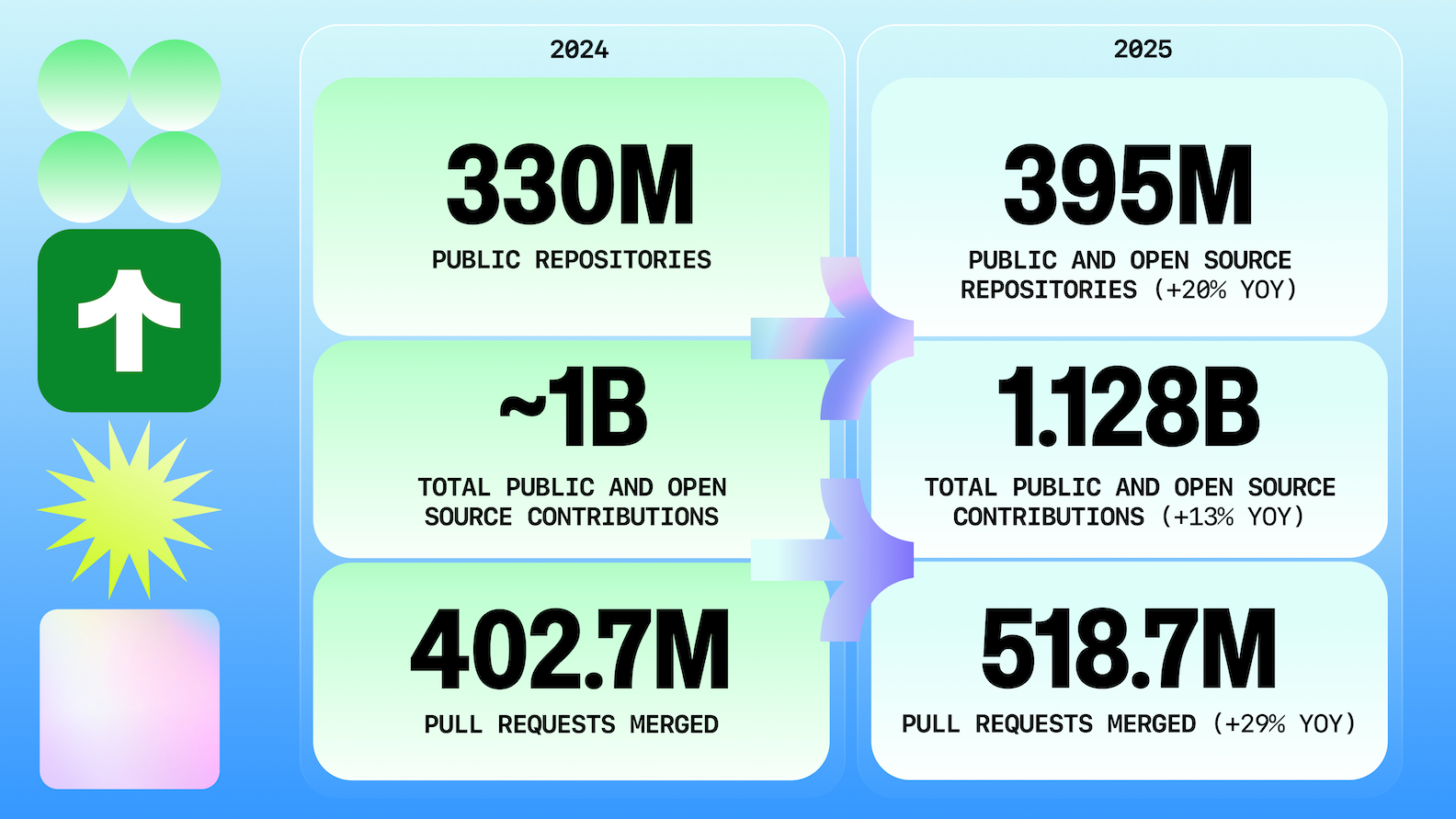
In total, 395 million public repositories hosted 1.12 billion contributions and 518.7 million merged pull requests—each a record.
This year’s fastest‑growing projects by contributors
Six of the 10 fastest-growing repositories were AI infrastructure projects, underscoring demand for runtimes, orchestration, and efficiency tools.
Standards also saw big growth: Model Context Protocol (MCP) hit 37k stars in just eight months, though it’s not on our lists below.
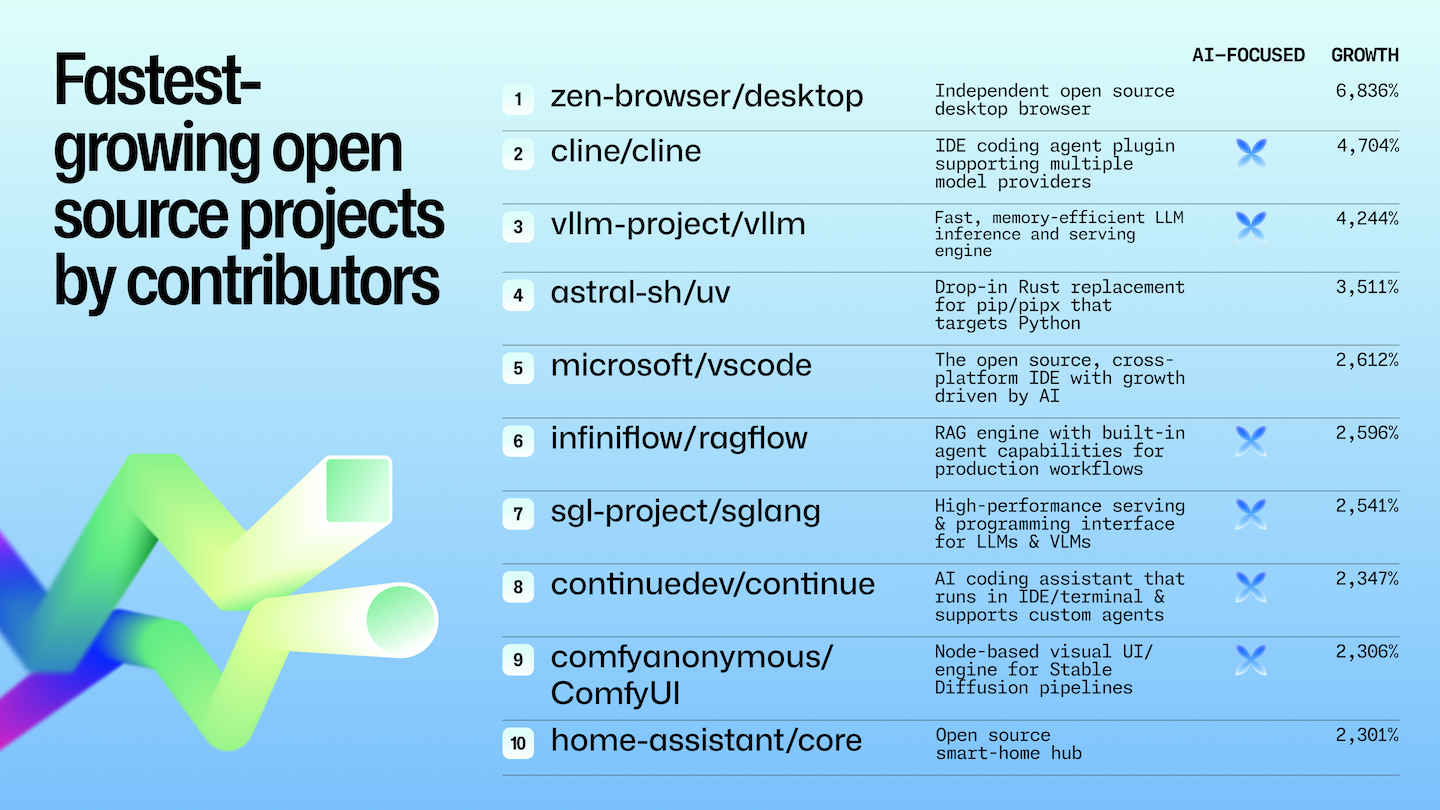
The top open source projects by contributors
2025’s top projects split between AI infrastructure (vllm, ollama, huggingface/transformers) and enduring ecosystems (vscode, godot, home-assistant).
- On one side, projects like vllm, ollama, ragflow, llama.cpp, and huggingface/transformers dominate, confirming that contributors are investing in the foundation layers of AI—model runtimes, inference engines, and orchestration frameworks.
- On the other side, mainstay ecosystems such as vscode, godot, expo, and home-assistant continue to attract steady contributor bases, showing that open source momentum extends well beyond AI.
The takeaway? AI infrastructure is emerging as a major magnet, but developer ecosystems remain strong.
| Rank | Repository | Short description |
|---|---|---|
| 1 | vllm-project/vllm | High-throughput LLM inference engine |
| 2 | microsoft/vscode | Widely used open source code editor |
| 3 | openai/codex | Lightweight coding agent that runs in the terminal |
| 4 | huggingface/transformers | Core library for model loading & fine-tuning |
| 5 | godotengine/godot | Game engine for 2D/3D development |
| 6 | home-assistant/core | Open source smart-home hub |
| 7 | ollama/ollama | Local model runner and management tool |
| 8 | ggml-org/llama.cpp | Lightweight local Llama inference |
| 9 | volcengine/verl | LLM deployment & serving framework |
| 10 | expo/expo | React Native toolkit for mobile apps |
The fastest-growing projects by contributors show AI’s impact along with evergreen and utility projects
We see a mix of projects driving the fastest growth. zen-browser/desktop leads the pack, with fast-rising, AI-focused projects like vllm-project/vllm, continue-dev/continue, ollama/ollama, and Aider-AI/aider showing the pull of local inference, coding agents, and model runners.
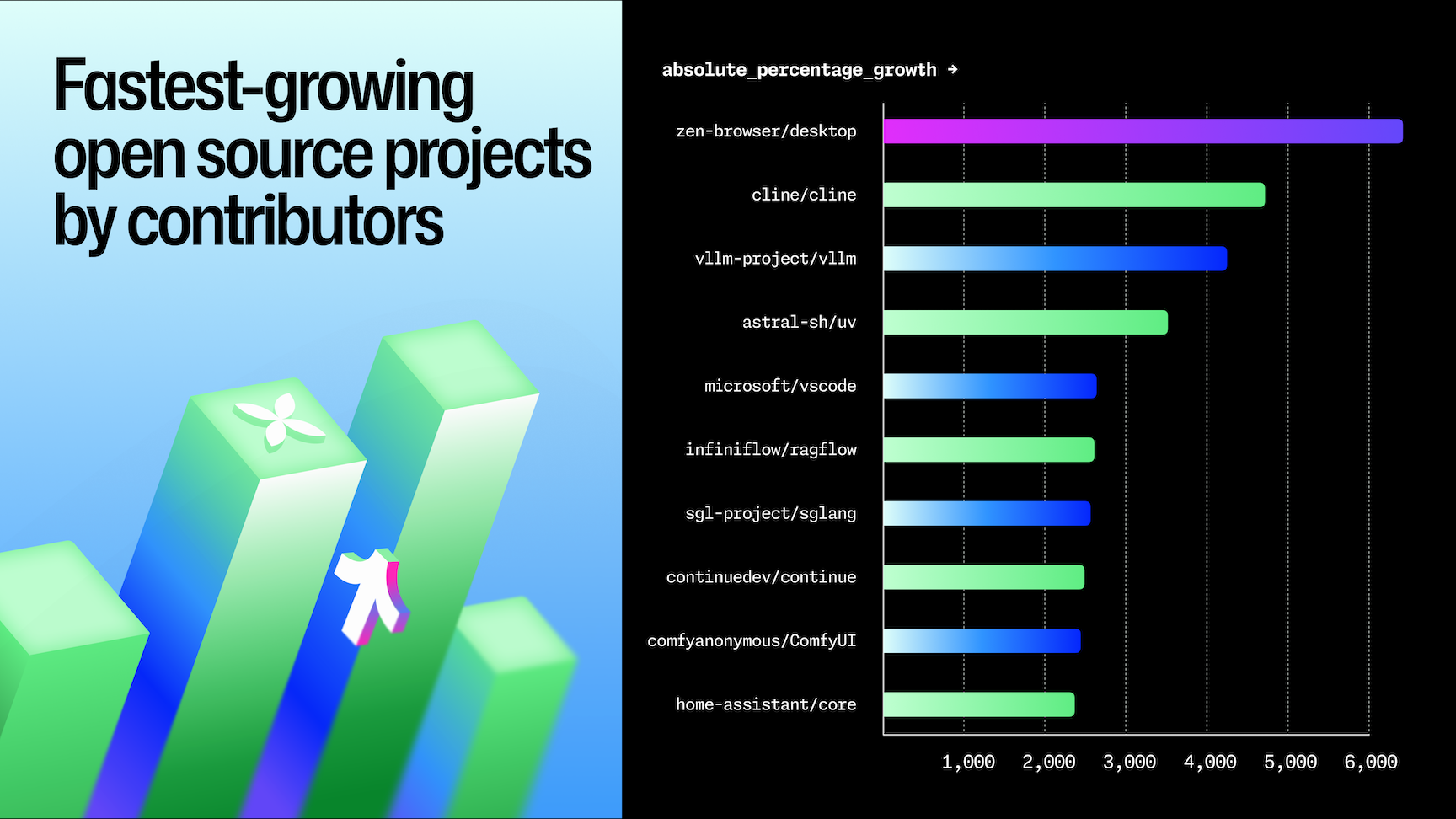
Growth in open source is broad. AI infrastructure projects are prominent among top-growth repositories. When we zoom out to the top 20 projects (not all of these are captured in our above graphic), we see a few things at play:
- Reproducibility and dependency hygiene are hot. The rise of astral-sh/uv and NixOS/nixpkgs points to a hunger for deterministic builds, faster installs, and less “works on my machine.”
- Performance-centric developer tools win attention. Ghostty, Tailwind CSS, and uv are all about speed, tight feedback loops, and minimal friction.
- Developers are contributing to projects that emphasize privacy and control. Zen Browser and Clash-Verge reflect interest in privacy, content control, and routing around networks.
- Open source social media continues to grow. As one of the biggest social projects, Bluesky’s momentum suggests developers are still investing in open protocols and portable identity.
AI, tinkering, and frontend projects attract first-time contributors
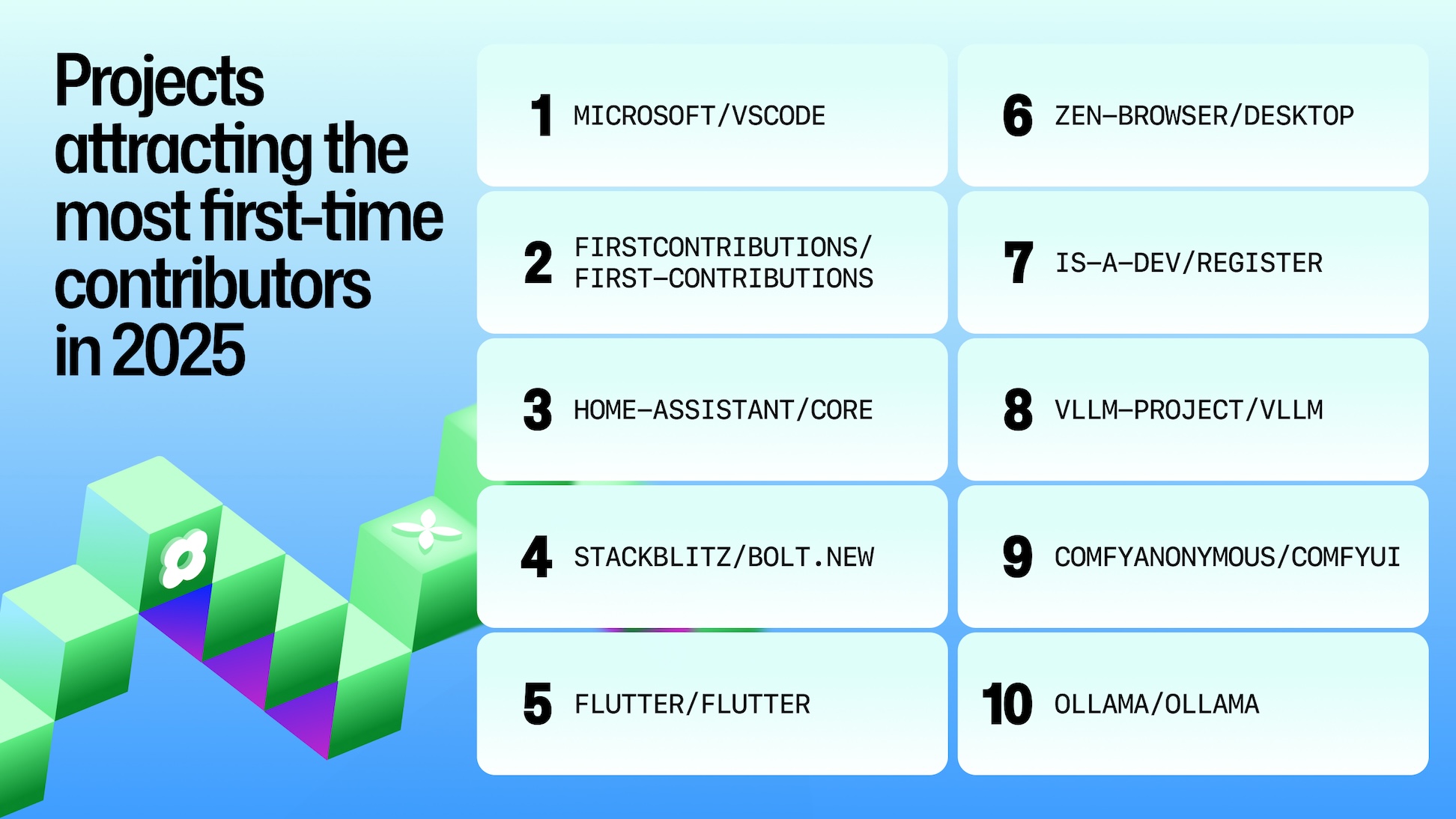
Nearly 20% of the most popular open source projects among first-time contributors in 2025 were AI-focused. But we’re also seeing other project types capture mindshare among developers who are new to open source.
- Most of the most popular projects sit firmly in AI infrastructure. Repositories like ollama/ollama, comfyanonymous/ComfyUI, and ultralytics/ultralytics appear prominently, confirming that newcomers want to experiment with models, create local runners, or build pipelines.
- Major platforms bring visibility. microsoft/vscode shows up as one of the top destinations for first-time contributors, underscoring the pull of widely used developer tools and the scale of contribution opportunities within them.
- firstcontributions/first-contributions exist almost entirely to help people submit their first pull request. Their year-over-year presence says first-timers still need and seek low-friction practice sandboxes.
- Smart-home, mobile, and game-dev ecosystems attract newcomers. Smart-home (home-assistant/core), mobile (flutter/flutter, expo/expo), game-dev (godotengine/godot), and 3D printing (bambulab/BambuStudio) rank closely behind the learning repositories. These ecosystems offer visible results on day one, which is perfect for those who want to “learn by doing.”
Frontend and dev tool projects also light up. shadcn/ui and uBlockOrigin/uAssets show that CSS, UI, and browser tooling remain magnets for fresh contributors.
The global landscape in open source activity
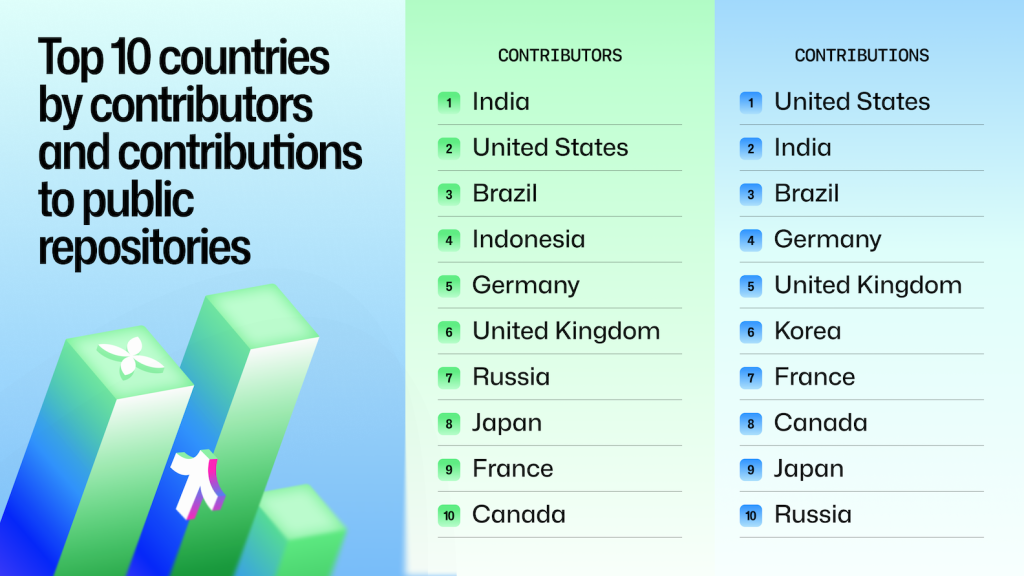
- India now has the largest public and open source contributor base in the world. This reflects both the country’s booming developer population and its increasing role in OSS adoption.
- The U.S. continues to lead in contributions. Despite having fewer contributors, U.S.-based developers contributed more to public and open source projects on GitHub. This suggests higher per-developer activity.
- Brazil, Indonesia, and Germany round out the next tier. Brazil contributes both strong headcount and volume, while Indonesia enters the top 5 for contributors, showing how emerging regions are shaping OSS.
Community health: Governance isn’t keeping pace with developer activity
Governance is not keeping pace with velocity. This gap presents an opportunity for developers, organizations, and companies to contribute documentation as well as code.
- README reach: ~63% of public repositories include a README, holding steady year over year.
- Contributor guides: At 5.5%, contributor guides remain an ecosystem-wide opportunity as the number of first-time contributors increases.
- Codes of Conduct: 2% penetration; governance still lags growth.
Key repository files like README or a LICENSE file are more than formalities. They’re foundational to scaling inclusive, legal, secure, and sustainable collaboration. This guide to getting your repository collaboration-ready shares what documentation is most important for fostering a sense of shared ownership.
Key takeaways for 2025
- 395M public and open source repositories (+19% YoY)
- 1.12B public and open source contributions (+13% YoY)
- 518.7M pull requests merged (+29% YoY)
- 60% of top 10 open source projects by contributors are AI‑focused
- Only 1 in 50 repositories ships with a Code of Conduct
Security: from “shift left” to secure by default

Average fix times for critical severity vulnerabilities have improved by 30% over the past year, as remediation is beginning to keep pace with faster software development.
Automation is driving this acceleration. Dependabot usage more than doubled (846k projects, +137% YoY), and AI tools like Copilot Autofix are resolving common OWASP Top 10 issues across thousands of repositories every month. This is underscored by the fact that in 2025, 26% fewer repositories received critical alerts through a combination of increased automation and AI usage.
At the same time, new risks are emerging. Broken Access Control overtook Injection as the most common CodeQL alert, flagged in 151k+ repositories (+172% YoY). Much of this stems from misconfigured permissions in CI/CD pipelines and AI-generated scaffolds that skip critical auth checks (GitHub’s engineers published a walkthrough of how they improved their SAML authentication flow, which offers some valuable lessons).
Automation is working (until the merge queue stalls)
Developers are automating more build, test, and security activity. In 2025, we saw developers use 11.5 billion total GitHub Actions minutes (measured in CPU minutes) in public projects for free. That’s up 35% year over year from 8.5 billion GitHub Actions in 2024. Note: in last year’s report, we included GitHub Actions minutes across public projects and self-hosted usage. If we use the same rubric this year, 13.5 billion minutes were used, which is up 30% from last year.
Automation raises fixes quickly, but merges still stall when approval depends on humans or policy. Projects that configure Dependabot with auto-merge rules remediate vulnerabilities more consistently than those relying solely on manual review.
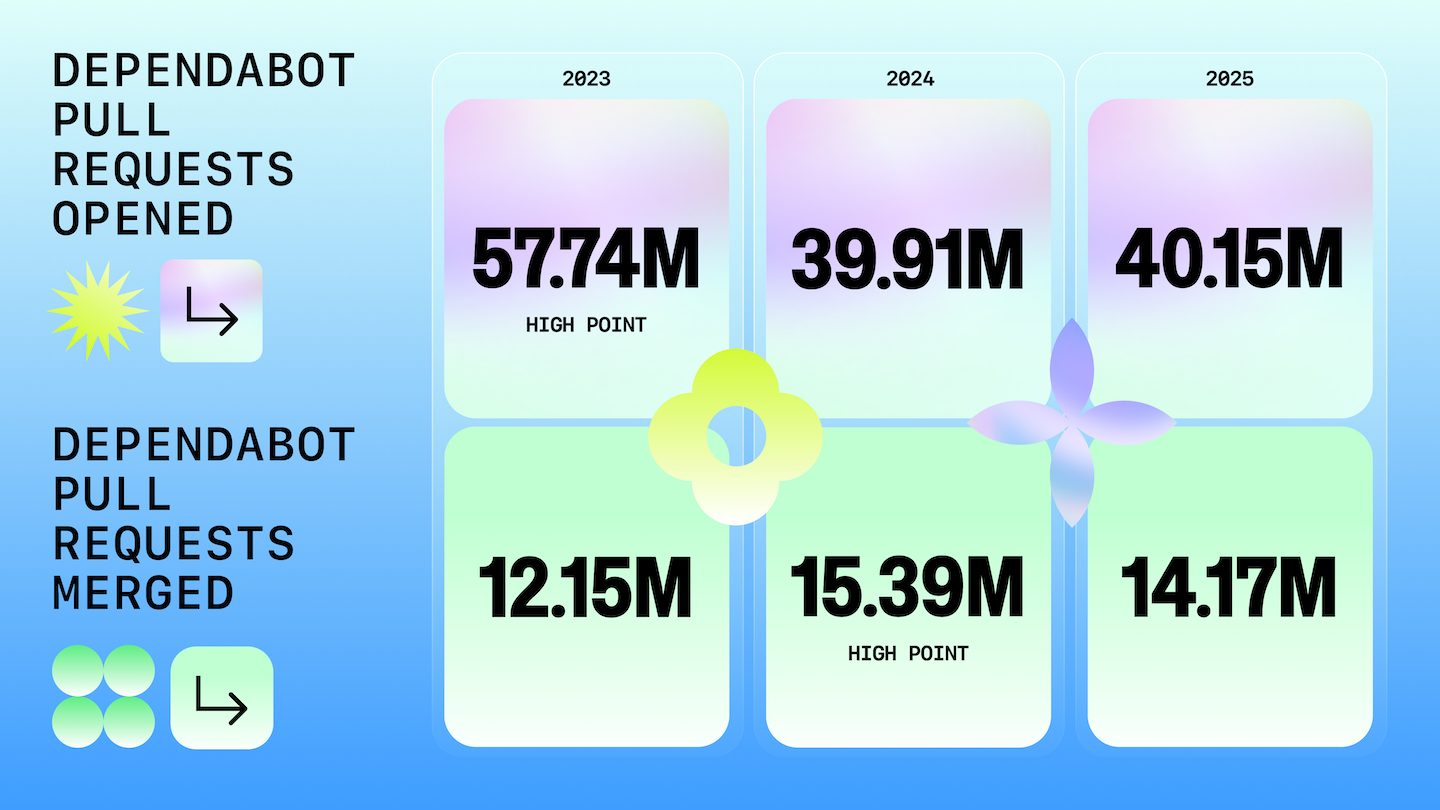
- We saw a peak of more than 12M Dependabot alerts in December 2022, which came a year after the Log4Shell vulnerability and immediately after key vulnerabilities in OpenSSL.
- Monthly openings have since settled near the 3-4M range, but merges hover around 1M. Only ~1 in 3 fixes ships within the same month it’s proposed.
- Security alerts follow the same pattern: brief spikes when new CVEs land, then a long tail of unresolved notifications (a number of which are likely attributable to zombie projects that are no longer maintained).
Faster fix times
In 2025, we saw 30% faster fixes of critical severity vulnerabilities with 26% fewer repositories receiving critical alerts. And this acceleration is happening at scale with the average fix time shrinking from 37 to 26 days in total.
Configuring and codifying security
Repositories that define Dependabot behavior in dependabot.yml more than doubled this year (846k, +137% YoY), marking a shift from “notify me” to “patch me automatically, within guardrails.”
| Signal | 2024 (cumulative) | 2025 (cumulative) | YoY |
|---|---|---|---|
Repositories with dependabot.yml | 356k | 846k | +137% |
CodeQL in 2025: Broken access control vulnerabilities spike
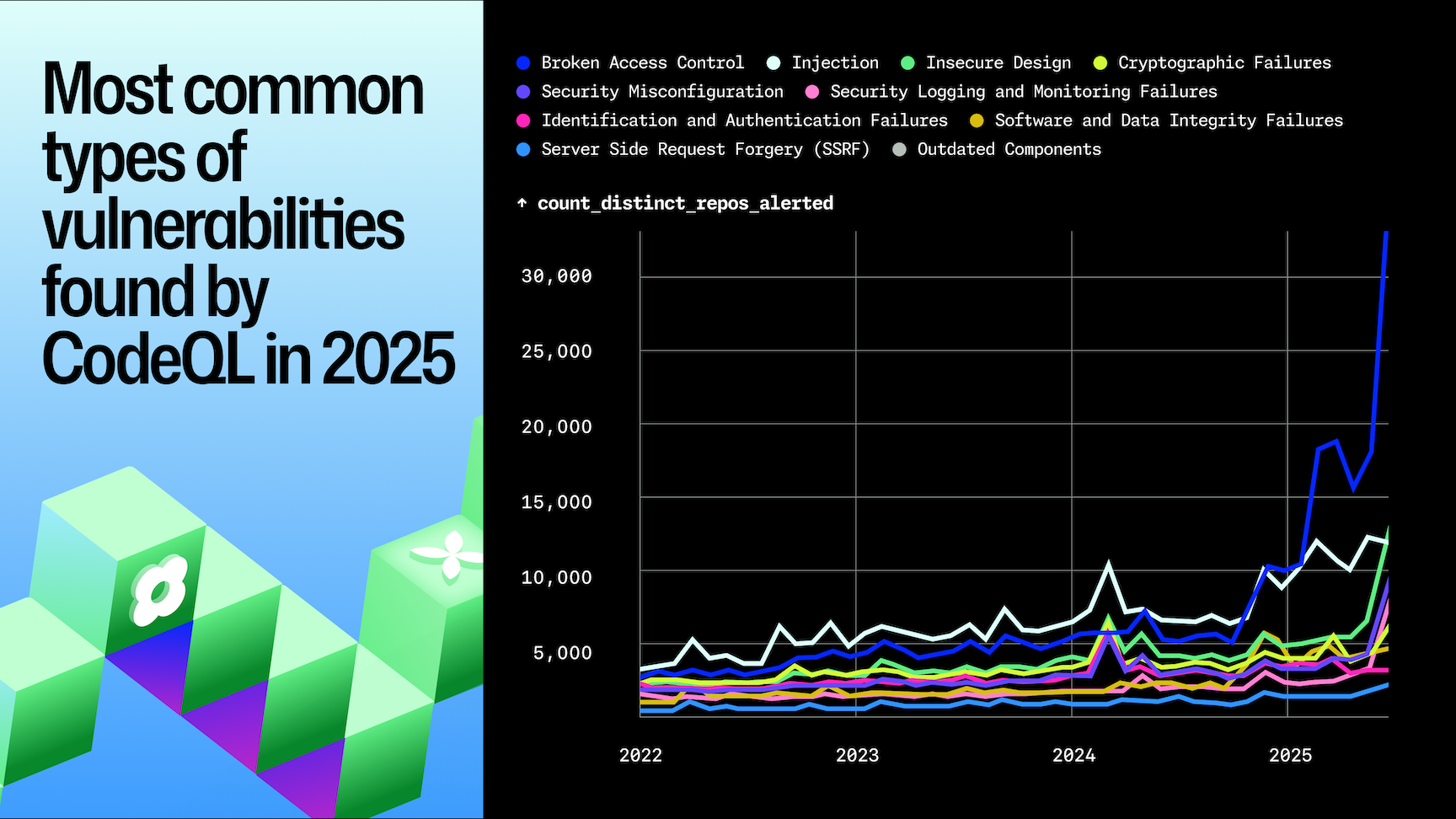
Broken Access Control overcame Injection to become the top CodeQL alert, flagged in 151k+ repositories. New CodeQL coverage for GitHub Actions revealed widespread misconfigured permissions and token scopes.
This points to a broader issue: authentication and authorization remain difficult for both developers and LLMs. Injection still dominates JavaScript, but Broken Access Control now leads in Python, Go, Java, and C++ (languages where AI-assisted “vibe coding” sometimes scaffolds endpoints that look correct but lack critical auth checks).
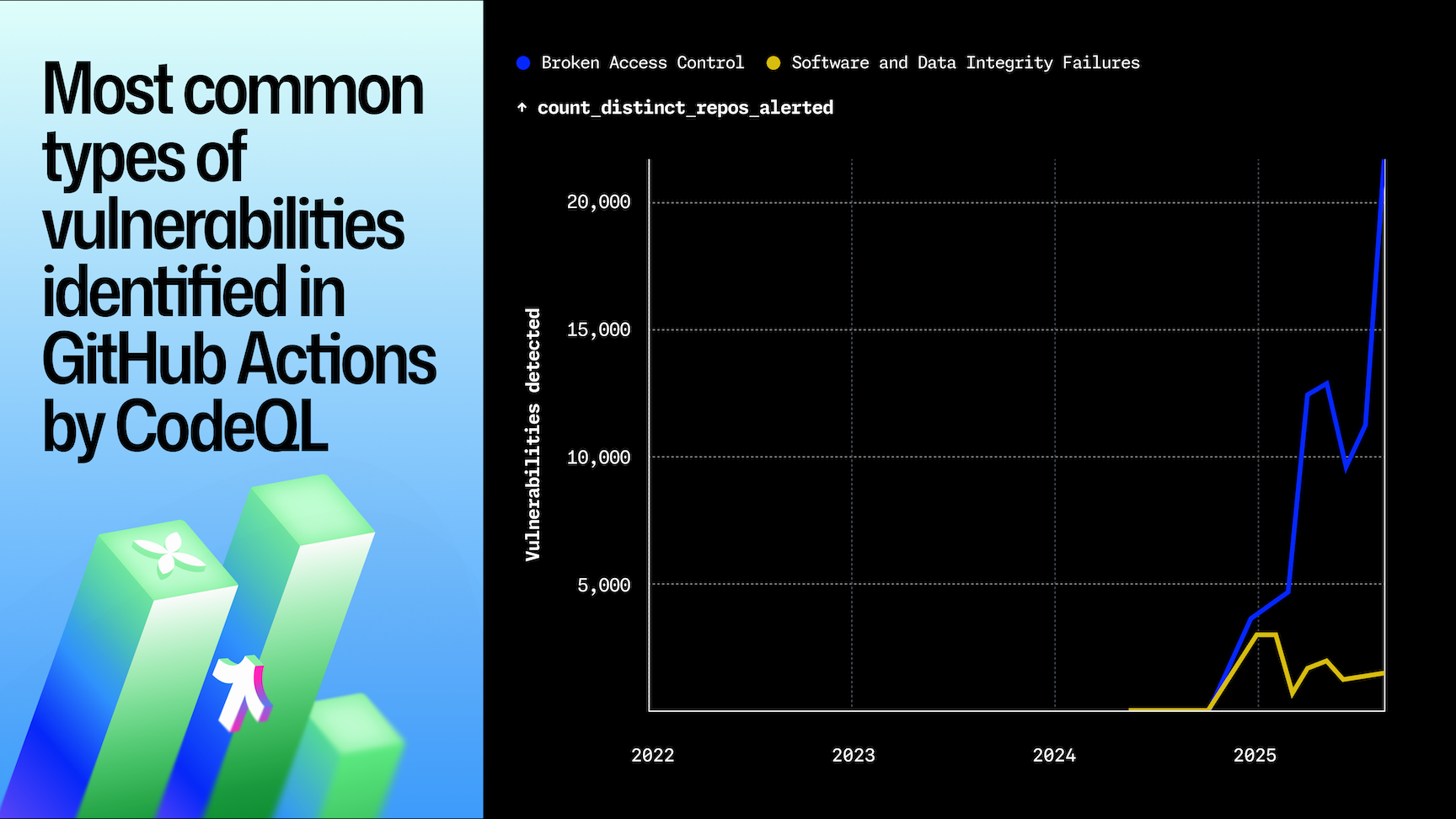
That same category became the fastest-growing target for Copilot Autofix. By mid-2025, developers were accepting AI-generated fixes for Broken Access Control in 6,000+ repositories per month. Autofix also gained traction for Injection (3,100 projects), Insecure Design (2,300 projects), and Logging/Monitoring failures (3,500 projects).
OpenSSF Scorecard status: 47 of the top 50 open source projects (94%) defined by their Mona ranking (combined ranking of stars, forks, and issue authors) now use the OpenSSF Scorecard via GitHub Actions or are independently scanned, bringing real-time checks for security best practices.
The top programming languages of 2025: TypeScript jumps to #1 while Python takes #2

By GitHub contributor counts, August 2025 marks the first time TypeScript emerged as the most used language on GitHub, surpassing Python by ~42k contributors (other industry indices use different methodologies and may still rank JavaScript and Python higher). This caps a decade-long trend of developers shifting toward typed JavaScript and signals a new default for modern development.
- TypeScript grew by over 1 million contributors in 2025 (+66% YoY), driven by frameworks that scaffold projects in TypeScript by default and by AI-assisted development that benefits from stricter type systems.
- Python remains dominant in AI and data science with 2.6 million contributors (+48% YoY). Jupyter Notebook remains the go-to exploratory environment for AI (≈403k repositories; +17.8% YoY inside AI-tagged projects).
- JavaScript is still massive (2.15M contributors), but its growth slowed as developers shifted toward TypeScript.
Together, TypeScript and Python now account for more than 5.2 million contributors (roughly 3% of all active GitHub developers in August 2025). The rise of typed languages suggests AI isn’t just changing the speed of coding, but also influencing which languages teams trust to take AI-generated code into production.
What changed in 2025
| Rank 2025 | Language | YoY contributor gain | YoY % growth (Aug 2024 vs. Aug 2025) | Big takeaway |
|---|---|---|---|---|
| 1 | TypeScript | ~1,054,015 | 66.63% | TypeScript overtook Python and JavaScript for #1 growth, showing its dominance in new green-field development. |
| 2 | Python | ~850,579 | 48.78% | Considered the lingua franca of AI and ML, Python’s usage has increased significantly amidst generative AI work. |
| 3 | JavaScript | ~427,148 | 24.79% | Still massive in scale, but more incremental growth as usage shifts toward TypeScript. |
| 4 | Java | ~174,705 | 20.73% | Java continues its steady enterprise-driven growth. |
| 5 | C# | ~136,735 | 22.22% | Cloud, desktop, and game dev keep momentum for C#. |
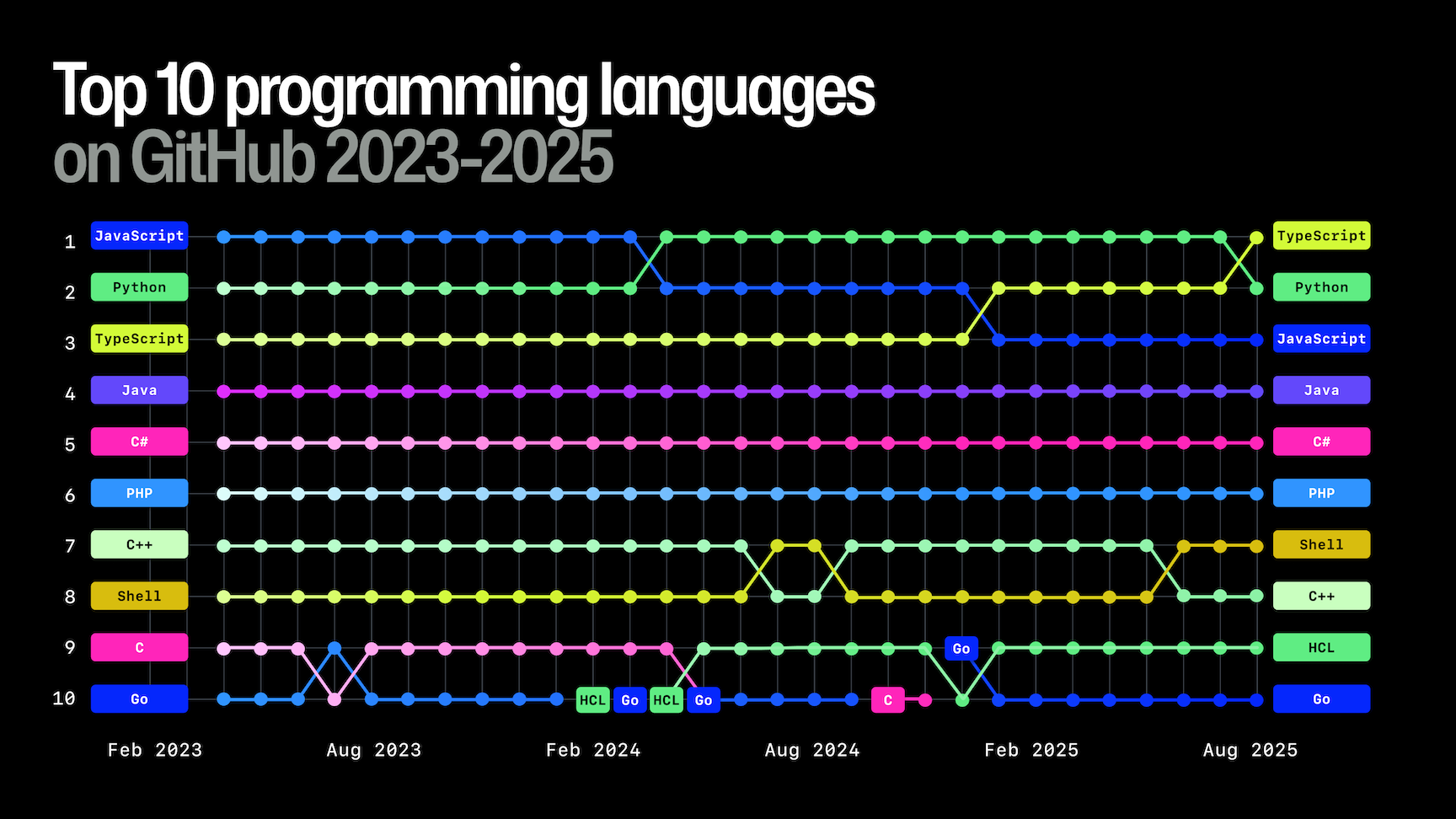
Python still trails the combined JavaScript and TypeScript ecosystem, a continuation of last year’s trend that highlights just how large the typed and untyped JavaScript community remains.
But starting in 2025, Python’s growth curve began to track almost identically in parallel with JavaScript and TypeScript, suggesting that AI adoption is influencing language choice across these ecosystems.
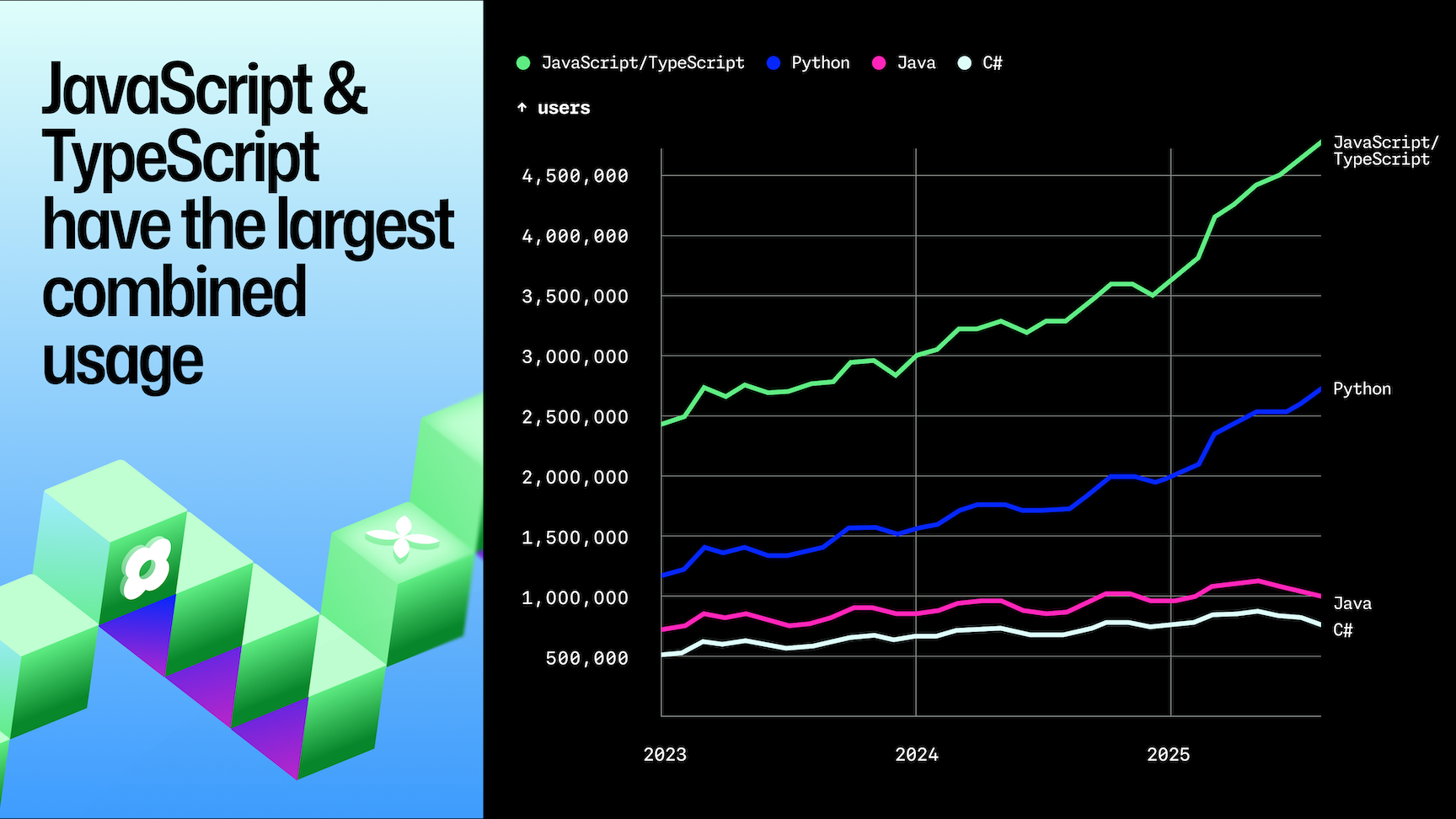
What else we’re seeing
- Python dominates AI projects. It remains the clear leader inside AI-tagged repositories, where Jupyter Notebook usage nearly doubled in 2025 offering evidence of its role as the go-to language for prototyping, training, and orchestrating AI workloads.
- Typed > loosely typed. TypeScript’s growth confirms our 2024 observation: much of what was previously counted as “JavaScript” activity already came through TypeScript transpilation pipelines. The data shows typed languages are increasingly becoming the default.
- Enterprise stacks endure. Java and C# each added over 100k contributors this year, showing steady growth across large enterprise and game-dev environments even as AI reshapes the landscape.
- Legacy experiments emerge. COBOL appeared in our dataset with nearly 3,000 active developers—likely driven by organizations and hobbyists creating AI-assisted tutorial repositories aimed at modernizing legacy codebases.
The fastest-growing languages by percentage growth
The following languages may not have the biggest developer communities behind them, but each has at least 1,000 monthly contributors and they’re posting the fastest year-over-year growth rates on GitHub.
| Language | Current developer count | YoY % | Why it’s hot |
|---|---|---|---|
| Luau | >3,600 | >194% | Luau is Roblox’s scripting language and a gradually typed language, reflecting a broader industry trend toward typed flexibility. |
| Typst | >3,600 | >108% | As a modern LaTeX alternative, Typst aims to make academic and technical publishing faster, less cryptic, and more collaborative. |
| Astro | >45,600 | >78% | Astro’s “islands architecture” and focus on shipping zero-JavaScript by default resonate with developers building fast, content-heavy sites (we added Astro to Linguist in 2021, which is our source for languages). |
| Blade | >91,100 | >67% | As Laravel’s templating engine, Blade rides on Laravel’s continued dominance in PHP web development. |
| TypeScript | >2,600,000 | >67% | Offering type safety for the JavaScript world, TypeScript’s combination of JavaScript ubiquity and type safety is compelling for both greenfield and legacy projects (plus, its types work well with AI coding tools). |
Core stacks for new projects built in the last 12 months
Nearly 80% of new repositories used just six languages: Python, JavaScript, TypeScript, Java, C++, and C#. These core languages anchor most modern development.
| Language | Total repositories (Sep 2024-Aug 2025) | Growth (Jan-Aug 2025 vs. Jan-Aug 2024) | What this growth tells us |
|---|---|---|---|
| Python | 9,261,587 | 53.41% | AI’s default glue with growth driven by ML, agents, notebooks, and orchestration. |
| JavaScript | 9,345,046 | 14.57% | Still ubiquitous for scripts and web apps, though growth is slower as TypeScript gains share. |
| TypeScript | 5,394,256 | 78.10% | Typed standard for modern web dev. Ideal for safe API/SDK integration, especially with AI. |
| Java | 3,520,215 | 9.35% | Reliable enterprise and backend workhorse. Gradual AI integration without language churn. |
| C++ | 1,701,552 | 11.82% | Performance-critical workloads used in game engines, inference, and embedded systems supporting AI. |
| C# | 1,478,463 | 10.61% | Steady enterprise and game dev usage, with AI capabilities folded into established ecosystems. |
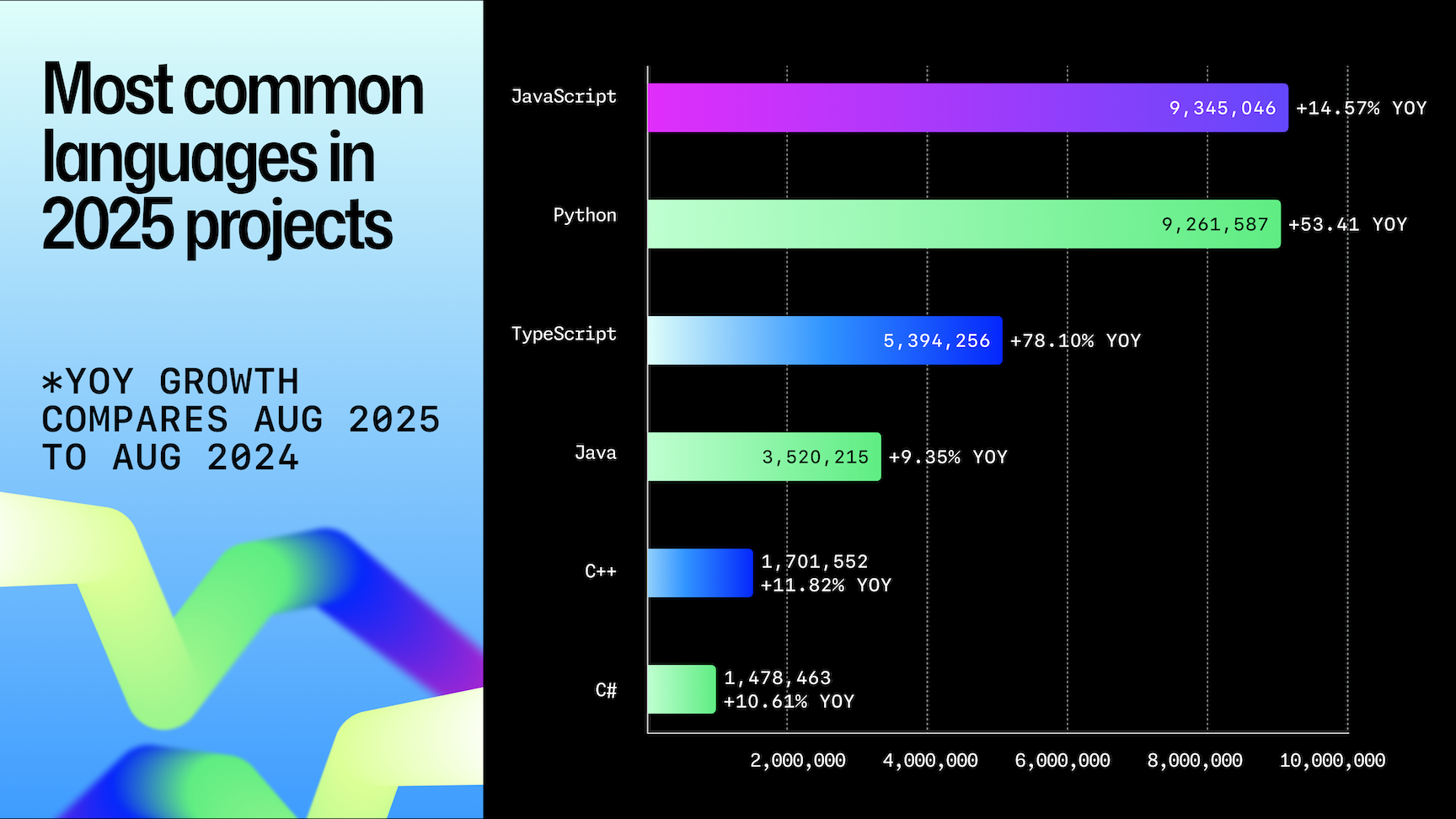
Additional insights:
- Experimentation is becoming more common. Though not a language, Jupyter Notebooks grew 24.5% YoY, with exploratory LLM experiments and data analysis now generating new standalone repos rather than remaining siloed in monorepos.
- Performance and systems languages are rising with AI (but not evenly). C grew ~20.9% YoY and C++ grew ~11.8% YoY, reflecting demand for faster runtimes, inference engines, and hardware-optimized loops.
- .NET stays strong. C# grew ~10.6% YoY, consistent with enterprise and game/tooling ecosystems. This suggests AI features are being integrated into existing .NET workflows rather than driving a wholesale language shift.
The languages powering AI development
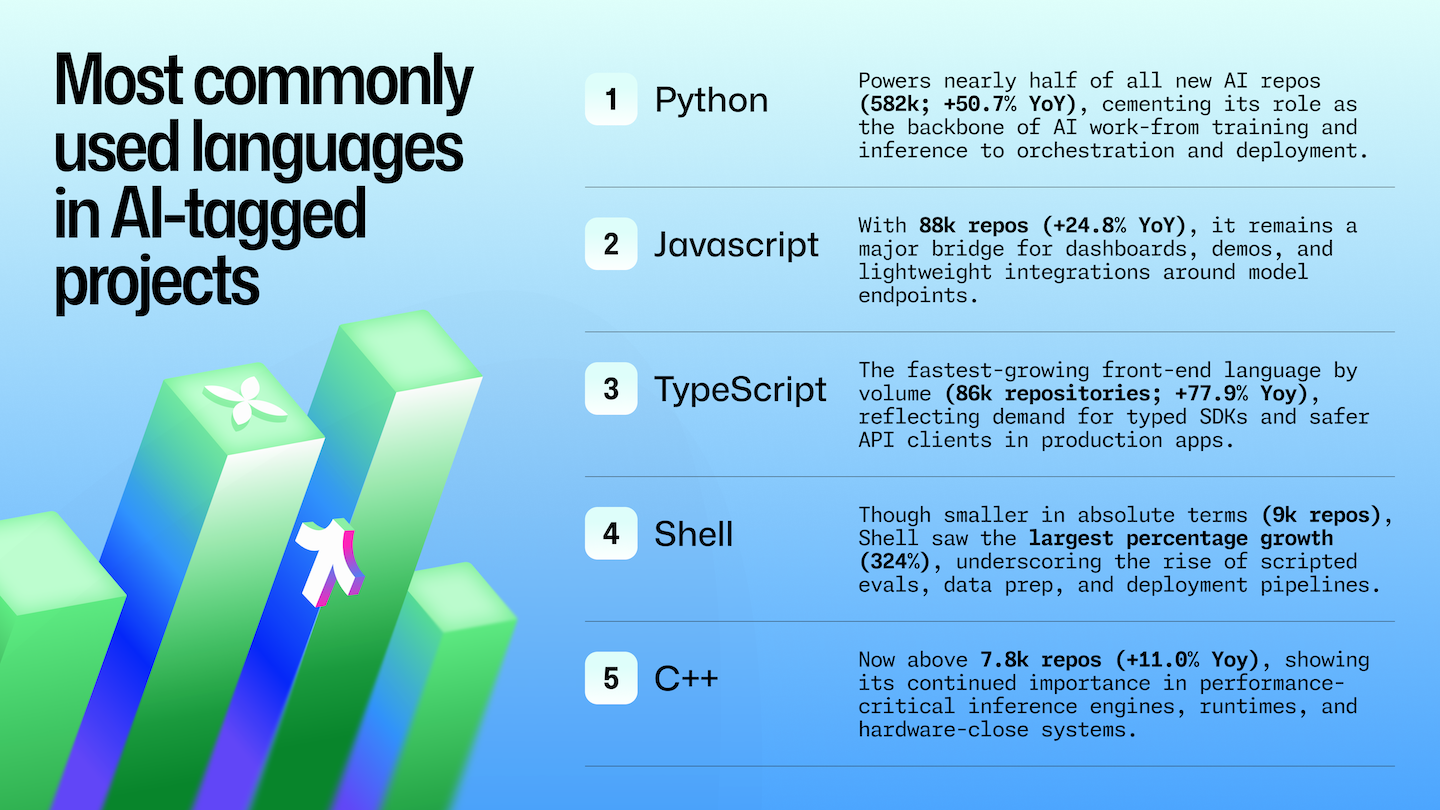
Python and Jupyter Notebook continue to anchor new AI projects, but the story this year is Python’s growth. Python now powers nearly half of all new AI repositories (582,196; +50.7% YoY), underscoring its role as the backbone of applied AI work, from training and inference to orchestration and deployment. Jupyter Notebook remains the go-to exploratory environment for experimentation (402,643; +17.8% YoY), but the shift toward Python codebases signals more projects moving out of prototypes and into production stacks.
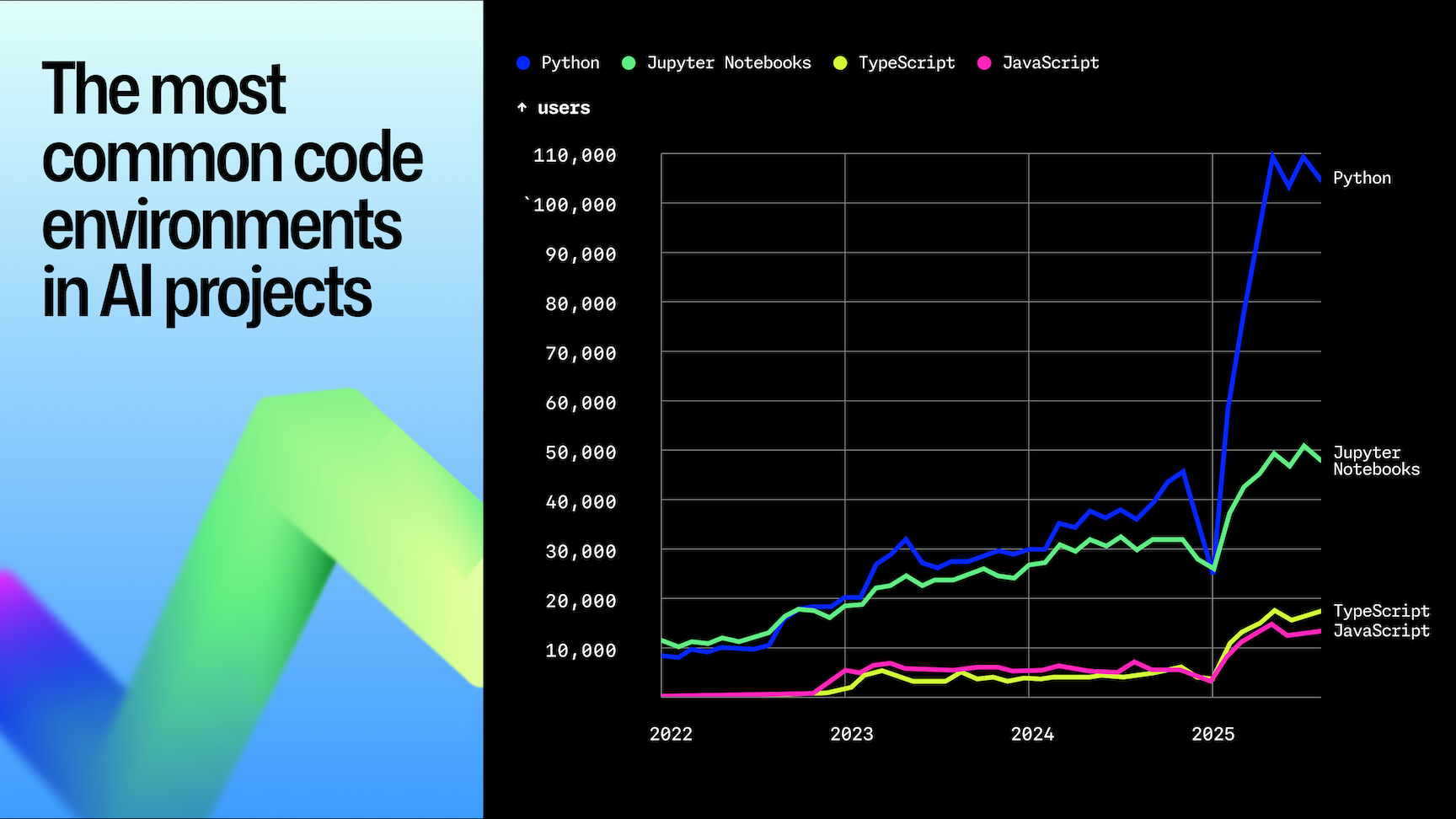
Front-end and app-layer languages grew sharply from smaller bases—TypeScript +77.9% (85,746) and JavaScript +24.8% (88,023)—mirroring the rise of demos, dashboards, and lightweight apps built around model endpoints. Shell scripts (+324%) emerged as the fastest riser, reflecting how teams codify eval harnesses, data prep, and deployment pipelines. And C++ crossed 7,800 repos (+11%), a steady reminder of its role in performance-critical inference engines, runtimes, and hardware-close systems.
Generative AI and agentic workflows become ordinary engineering

Last year we saw AI move from experiment to mainstream. In 2025, it became part of the everyday workflow. And no matter what tool developers used over the last 12 months, their work converged on GitHub.
- AI-related repositories on GitHub now exceed 4.3 million, nearly doubling in less than two years.
- Roughly 80% of new GitHub users tried Copilot within their first week, showing that AI is no longer an advanced tool to grow into, but part of the default developer experience.
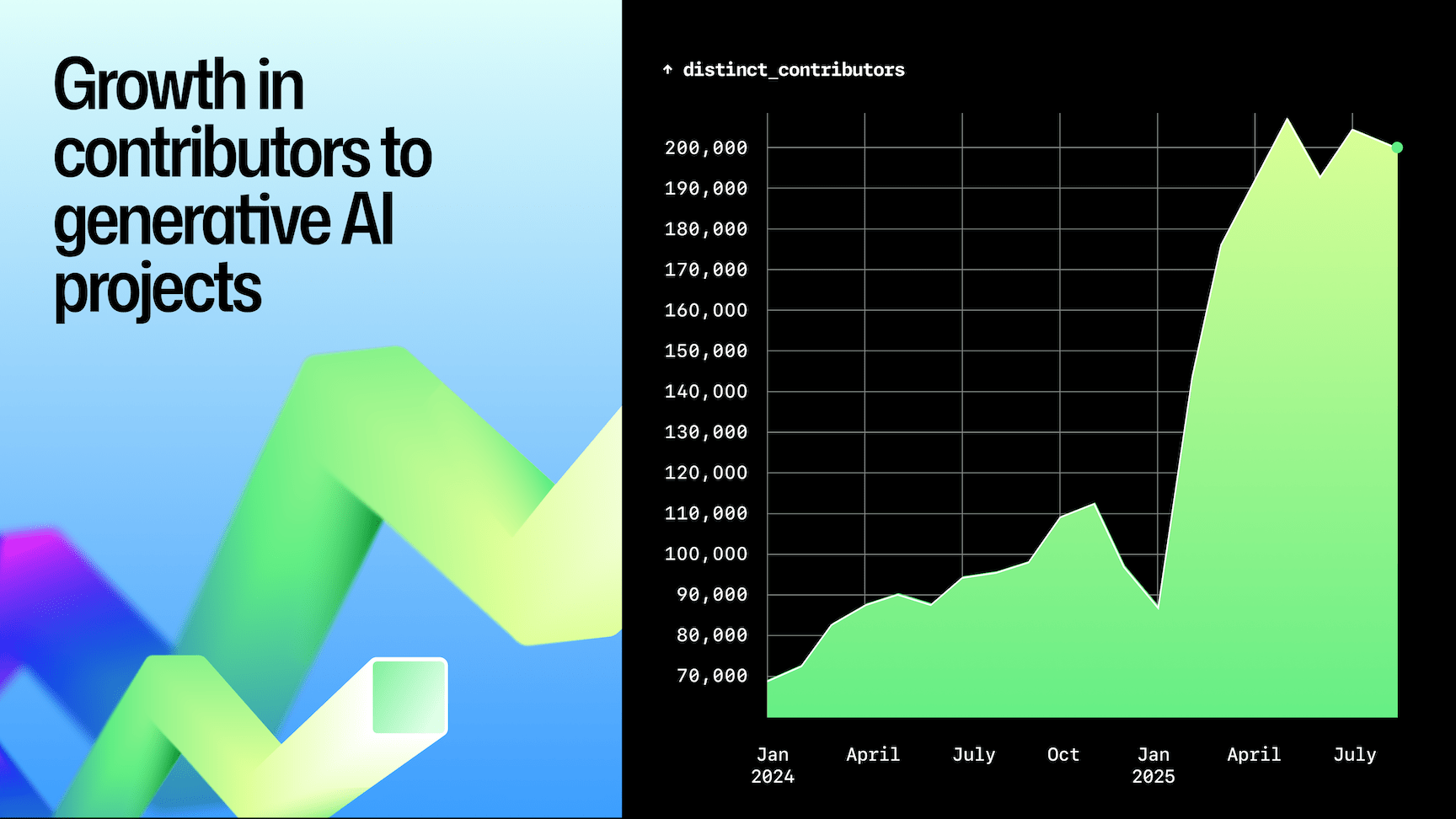
Monthly contributors to generative-AI projects climbed sharply across our measurement year. From September 2024 through August 2025, months averaged ~151k contributors (median ~160k). Activity rose from ~86k in January 2025 to a peak of 206,830 in May (+132% YoY vs. May 2024). It then held near ~200k through the summer. On a like-for-like basis, Jan–Aug 2025 averaged ~175k contributors, up +108% YoY vs. Jan–Aug 2024 (~84k), indicating a durable step-change rather than a one-off spike.
Key takeaways:
- Generative AI is becoming infrastructure. More than 1.1M public repositories now import an LLM SDK (+178% YoY, August ‘25 vs. August ‘24), supported by 1.05M+ contributors and 1.75M monthly commits (+4.8X since 2023).
- Growth surged early in the calendar year, then normalized as projects shifted from experimentation to shipping. Contributors ran +100-118% YoY from Feb-May 2025, then cooled to +31% (Jun), +11% (Jul), and -3% (Aug) as teams focused on shipping vs. experimenting.
- AI in open source. Half (50%) of open source projects have at least one maintainer using GitHub Copilot.
- Early evidence of a prototype-to-production pivot. Python-based code accelerated mid-2025 while Notebook growth flattened—signaling packaging into production. (By year’s end, Notebooks rebounded, keeping pace with Python.)
Strong signals of mainstream appeal
| Data point | Why it matters | |
|---|---|---|
| 178% YoY increase in projects that import an LLM SDK | 1.13M+ public repositories now import an LLM SDK; 693k+ were created in the last 12 months alone. | Growth rates indicate a shift from early experimentation to sustained building. |
| Contributors up >3X since 2023 | Monthly distinct contributors to AI repos rose from 68k (Jan 2024) to ~200k (Aug 2025). August 2025 is up 111% YoY vs. August 2024. | AI work is no longer the domain of specialists. |
| Monthly contributions near 6M | Monthly commits/contributions to AI projects reached ~6.0M (Aug 2025) hitting a peak of 6.28M (Jun 2025). August 2025 is up 188% YoY vs. August 2024. | More code, more often, offering evidence of production-grade adoption and active iteration. |
Scale replaces hype
1.13M+ public repositories now depend on generative-AI SDKs (up 178% YoY). More than 693k+ were created in the last 12 months, sharply outpacing 2024’s total (~400,000). The compounding curve that began in early 2023 shows no sign of tapering; every week, on average, we are still seeing new all-time highs.
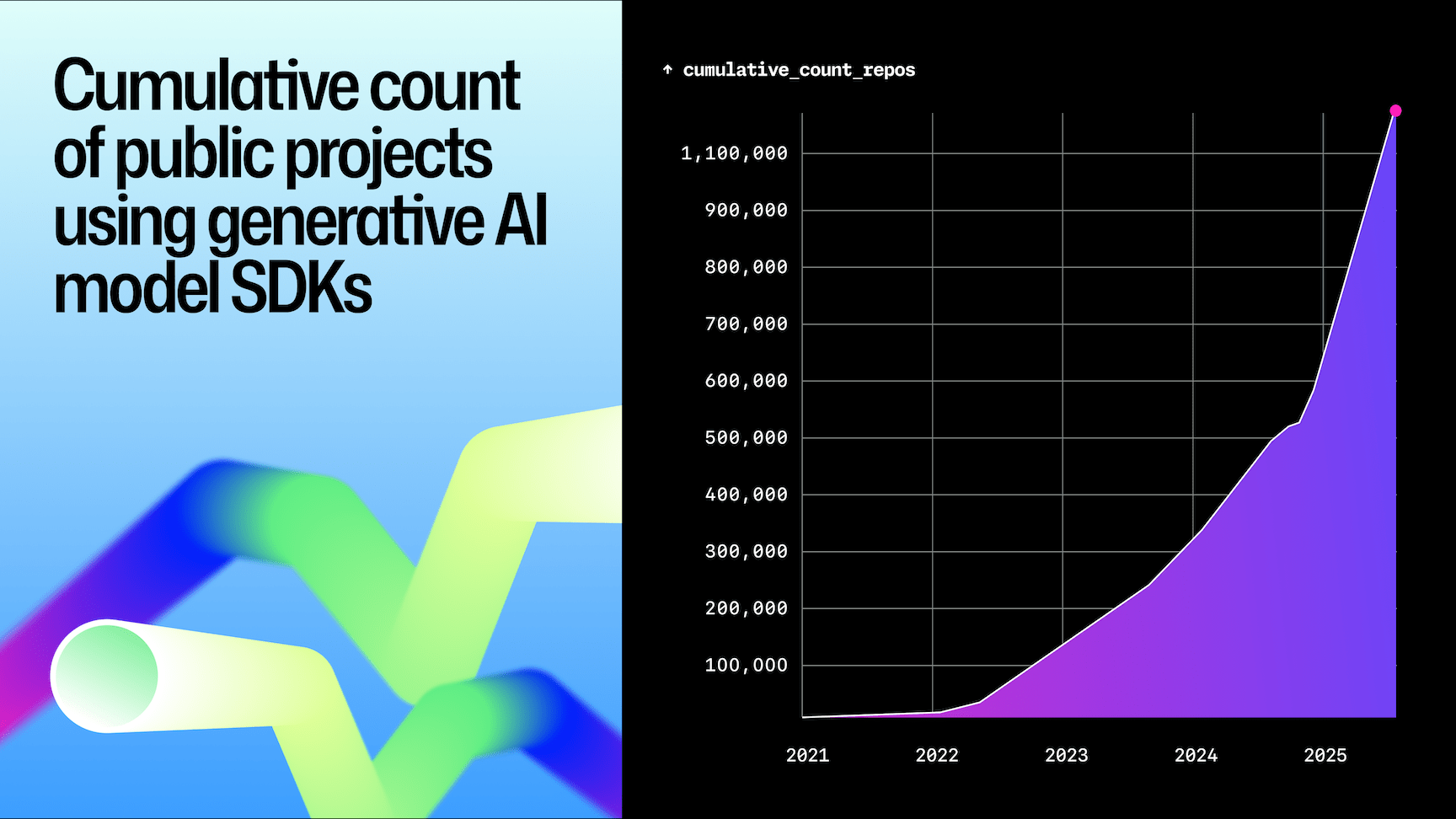
Who’s shipping the code?
The U.S. remains the largest source of contributions (~12.8M, 31.8%). India ranks second (~5M, 12.5%) and leads by distinct repositories (405k vs. 342k).
A second tier (Germany, Japan, U.K., Korea, Canada, Brazil, Spain, France) contributes another ~40%, globalizing the map.
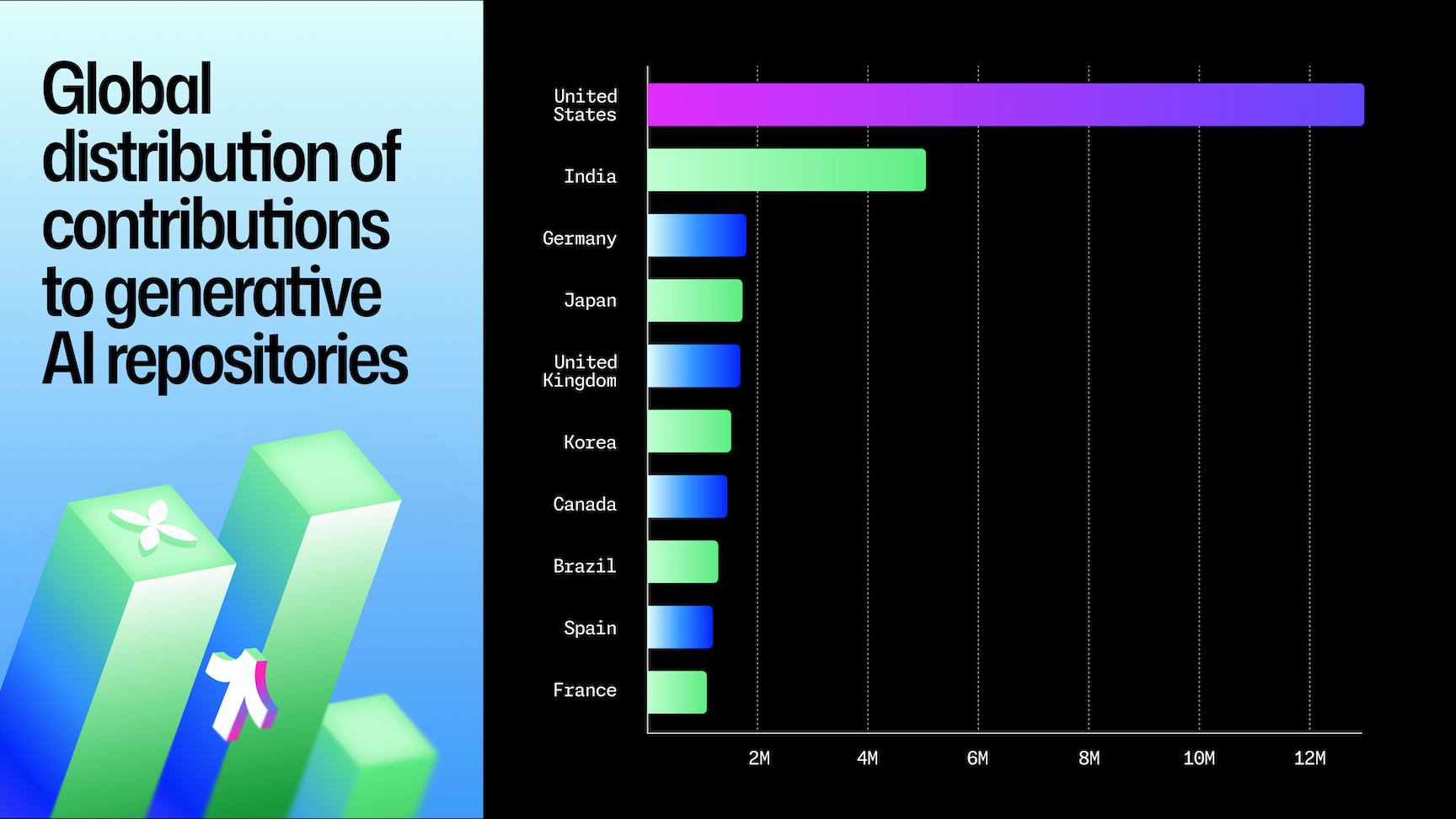
Agentic tools are now being adopted in day-to-day workflows
This year, GitHub Copilot coding agent went from demo to GA and we’re starting to see its impact.
A first glimpse of coding agent shows 1+ million pull requests that were created between May 2025 and September 2025.
Where it’s showing up:
A repository-level comparison of public repositories with ≥1 coding agent-authored pull request vs. a random sample without Copilot coding agent shows strong selection effects: coding agent activity is skewed toward repositories with more stars, larger size, and greater age. In other words, teams aren’t only assigning coding agent to throwaway projects; they’re trying it in better-known, more established projects as well.
We invite the community to run within-repository experiments (A/B or stepped-wedge) and matched analyses conditioned on size, stars, age, and complexity proxies to establish robust baselines. We’ll continue looking into this as we evolve coding agent across GitHub, the Copilot CLI, and more.
AI is driving notable breakouts in open source
Generative AI projects continue to be among GitHub’s most popular. Projects like vllm, ragflow, and ollama outpaced the historical contributor growth of staples such as vscode, home-assistant, flutter.
| Repository (age ≤3 yrs unless noted) | AI connection |
|---|---|
| vllm-project/vllm | Open source vision-language model + training/inference stack |
| ggml-org/llama.cpp | Local Llama inference on CPU/GPU |
| infiniflow/ragflow | End-to-end retrieval-augmented-generation (RAG) template |
| cline/cline | “LLM-native” command-line shell that reasons over local context |
| huggingface/transformers (6.6 yrs) | Defacto Python library for model loading/fine tuning |
What this tells us
- Software infrastructure outpaces everything else in velocity. Brand-new generative AI repositories (≤ 1 yr old) are racking up star counts that took other projects a decade to accumulate.
- Standards are emerging in real time. The rapid rise of Model Context Protocol (MCP) shows the community coalescing around interoperability standards.
- AI is reshaping classic tooling. Projects like ollama and ragflow show how local inference and AI-augmented pipelines are moving from proof-of-concept into mainstream developer workflows.
AI is helping developers fix code, too
GitHub Copilot Autofix contributed to measurable improvements in 2025:
- Broken access control surged the fastest, with fixes accepted in 6,000+ repositories per month by mid-2025.
- Security logging and monitoring failures, injection, insecure design, and misconfiguration fixes also climbed sharply, each crossing into the thousands of repositories monthly.
- Autofix is addressing the most common OWASP Top 10 issues—not just exotic vulnerabilities—bringing AI into the daily fabric of software security.
Here’s how to stay ahead
Early adopters using agents, open standards, and self-hosted inference are already setting the norms for the next decade. Continuous AI—systems and workflows that are updated, retrained, and deployed on an ongoing basis—is emerging.
- Expect AI libraries to become “plumbing.” If your stack can’t load a model or pipe context into one, you’ll feel legacy-bound quickly.
- Go beyond notebooks. Package your experiments early to share them with others.
- Watch the toolchain, not just the models. The next productivity leap may come from LLM-native editors, shells, and test runners growing out of today’s fast-rising repositories.
- Build for interoperability. Standards like MCP and Llama-derived protocols are gaining momentum across ecosystems.
Take this with you
Three years ago, we said AI wouldn’t replace developers—it would bring more people into the ecosystem. The data now proves it: activity on GitHub has reached record levels, with more contributors, more repositories, and more experimentation than ever.
The past year marked historic milestones:
- India overtook the United States as the largest contributor base to public and open source projects on GitHub. It’s also poised to overtake the US developer population within the next few years, underscoring how global the developer community has become.
- TypeScript became the most used language for the first time, overtaking both Python and JavaScript and signaling a generational shift in how modern software is built.
- Open source remains the foundation. Public projects supply the libraries, models, and workflows that power most private development. The strength of this ecosystem and the maintainers who sustain it will determine how far and how fast the next wave of software innovation goes.
The story of 2025 isn’t AI versus developers. It’s about the evolution of developers in the AI era where they orchestrate agents, shape languages, and drive ecosystems. No matter which agent, IDE, or framework they choose, GitHub is where it all converges.
Glossary
- 2025: Refers to September 1, 2024 through August 31, 2025.
- Year-over-year language comparisons: Unless otherwise noted, YoY values reflect same-month comparisons (e.g., Aug 2025 vs Aug 2024) to normalize for month-length and seasonality in developer activity.
- Contributions: Commenting on a commit, issue, pull request, pull request diff, or team discussion; creating a gist, issue, pull request, or team discussion; pushing commits to a project; and reviewing a pull request.
- Contributors: GitHub users who have performed any of the contribution activities defined above.
- Developer: Anyone with a GitHub account. Also sometimes referred to as a GitHub user. The open source and developer communities are an increasingly diverse and global group of people who tinker with code, make non-code contributions, conduct scientific research, and more. GitHub users drive open source innovation, and they work across industries—from software development to data analysis and design.
- Total repositories: The combined number of public and private repositories on GitHub.
- Programming language usage: Unless otherwise noted, “most used” languages are ranked by the number of distinct monthly contributors who committed code in that language. This is the standard measure for “TypeScript became the most used language on GitHub.”
- AI-related repository: Any repository tagged with AI-related topics (e.g., “AI,” “ML,” “LLM”) or falling under our AI classification methodology. This broad category captures general experimentation and projects adjacent to AI.
- Agentic workflows: Software development tasks completed with the aid of autonomous or semi-autonomous AI tools (e.g., GitHub Copilot coding agent creating pull requests, triaging issues, or running tests).
- Copilot coding agent: A GitHub Copilot feature that can independently draft code, run tests, and open draft pull requests in a secure environment—subject to developer review and approval.
- Copilot code review: A GitHub Copilot feature that reviews pull requests, suggests changes, and surfaces potential issues before merging.
- GitHub Actions minutes: CPU minutes used to execute GitHub Actions (CI/CD workflows). Reported cumulatively and as YoY growth.
- CodeQL: GitHub’s semantic code analysis engine used to detect security vulnerabilities. Alerts are categorized by vulnerability type (e.g., Broken Access Control, Injection, Insecure Design).
- Mona rank: Ranks repositories based on their stars, forks, and unique issue authors in the repository. The steps to compute Mona rank: 1) Calculate individual ranks based on stars, forks, and issue authors. 2) Sum these individual ranks. 3) Assign the final “Mona Rank” based on the summed rank.
- LLM SDK: A set of official libraries and tools published by model providers (such as OpenAI, Anthropic, Meta, Mistral, Cohere, or AI21) that make it easier for developers to connect to and use their large language models. These SDKs wrap the underlying model APIs with client libraries, helper functions, and runtime integrations, letting developers handle prompts, responses, tokens, and extensions without needing to build low-level infrastructure. To determine usage of LLM SDKs, we referenced models offered via GitHub Models. These included SDKs from DeepSeek, Grok, Mistral, Phi, OpenAI, Cohere, Llama, and AI21.
Methodology
Scope & coverage
- Octoverse year: Sep 1, 2024 through Aug 31, 2025.
- Unless noted, metrics reflect public activity only. Public indicators are also available on the GitHub Innovation Graph. For country-level reporting there, we publish metrics only when ≥100 unique developers performed the activity in the period.
Time windows
- Monthly snapshots: Calendar-month metrics to show peaks/turning points (e.g., Aug 2025 language rankings).
- Trailing-12-month (T12): Sep ’24–Aug ’25 vs Sep ’23–Aug ’24 for year-over-year trends/averages.
- Longer lookbacks: Historical context from Jan 2022 → Aug 2025 where relevant.
Units & entities
- Contributors/developers: Monthly unique users per metric (e.g., per language). One user can appear in multiple categories in the same month, so these do not sum across categories.
- Repositories: Counted in a month if created or active, per metric definition.
- Activities: “pushes,” “pull requests created/merged,” “comments,” etc., follow standard GitHub event definitions.
Growth baselines
- Same-month YoY: Month vs. the same month prior year (e.g., Aug ’25 vs Aug ’24) are used for milestones/seasonality control as in language comparisons.
- T12 YoY: Trailing-12-month total or average vs the prior trailing-12-month metric are used for sustained trends (e.g., average monthly contributors, pull requests per month).
- Stock vs. flow (cumulative metrics): Stock = level at a point in time (e.g., SDK repos as of Aug ’25). Flow = adds over a window (e.g., Sep ’24–Aug ’25). Labeled distinctly.
Geography
- Developers are mapped to countries via self-reported locations, standardized to ISO country codes; country aggregates observe the ≥100 developers publication threshold.
Repository & language classification
- Primary language: GitHub language detection (e.g., Linguist); mixed-language repositories are attributed to one primary language.
- Notebooks: “Jupyter Notebook” is a development-environment classification and is labeled transparently.
- AI projects: Identified via signals such as generative-AI SDK usage (imports/dependencies) and related metadata.
- Open source quality signals: Presence of files/policies (e.g., codes of conduct) from repository metadata.
Statistical techniques
- Monthly time-series tracking; cumulative counts for stock growth; Top-N rankings (contributors, repo counts, growth rates, activity volumes).
- Minimum thresholds to reduce noise (e.g., lists may require ≥1,000 contributors or ≥X repos; metric-specific).
User de-duplication
- Count unique users per time period and per metric to avoid within-slice double counting; cross-category duplication is expected by design.
Data quality controls
- Exclude incomplete months (e.g., the current month) from YoY/T12.
- Filter bots/automation where identifiable (account flags + behavioral heuristics).
- Enforce minimum activity for inclusion in growth and rankings.
- Cross-validate against multiple internal/public sources (e.g., Innovation Graph).
Interpretation & reproducibility
- Seasonality: motivates same-month YoY for snapshots and T12 for structure.
- Attribution: primary language is repository-level; TypeScript/JavaScript mixes may appear under one language.
- Scope: public-only views undercount private activity but preserve directionality.
- Public counterparts for several metrics can be verified via the Innovation Graph.
Developer growth projections
- Forecasting models: a collection of time-series and regression models that use historical data and statistics to predict future outcomes. Forecasting models relied on historical GitHub data, sign-up rates and product usage, as well as market-sizing information.
- Accuracy of forecasts: No forecast is ever accurate. Backtesting shows models used for forecasting growth projections were within reasonable levels of accuracy (less than 30% Mean Absolute Percentage Error).
- External factors: Forecasts do not take into account competitive landscape changes, geopolitical/economic conditions, or future covariates (product/feature releases that may shift responses differently from historical data).
The post Octoverse: A new developer joins GitHub every second as AI leads TypeScript to #1 appeared first on The GitHub Blog.
In this year’s Octoverse, we uncover how AI, agents, and typed languages are driving the biggest shifts in software development in more than a decade.
The post Octoverse: A new developer joins GitHub every second as AI leads TypeScript to #1 appeared first on The GitHub Blog.






Social Plugin